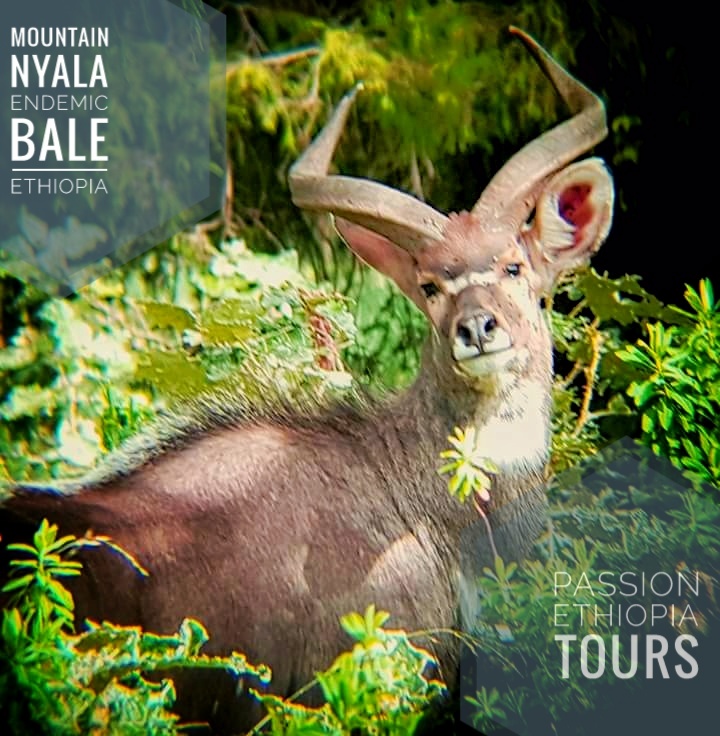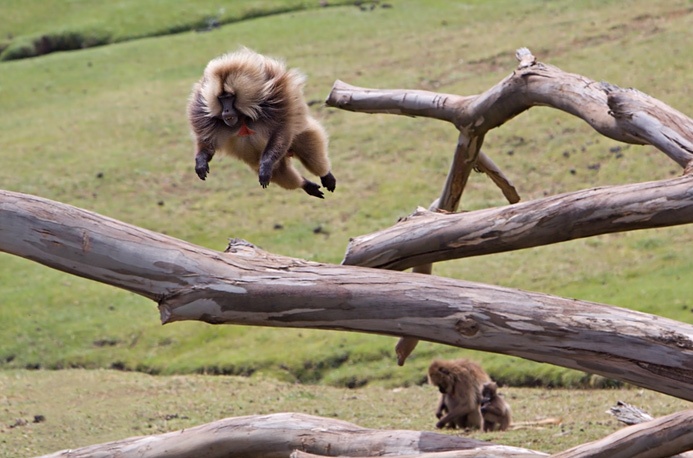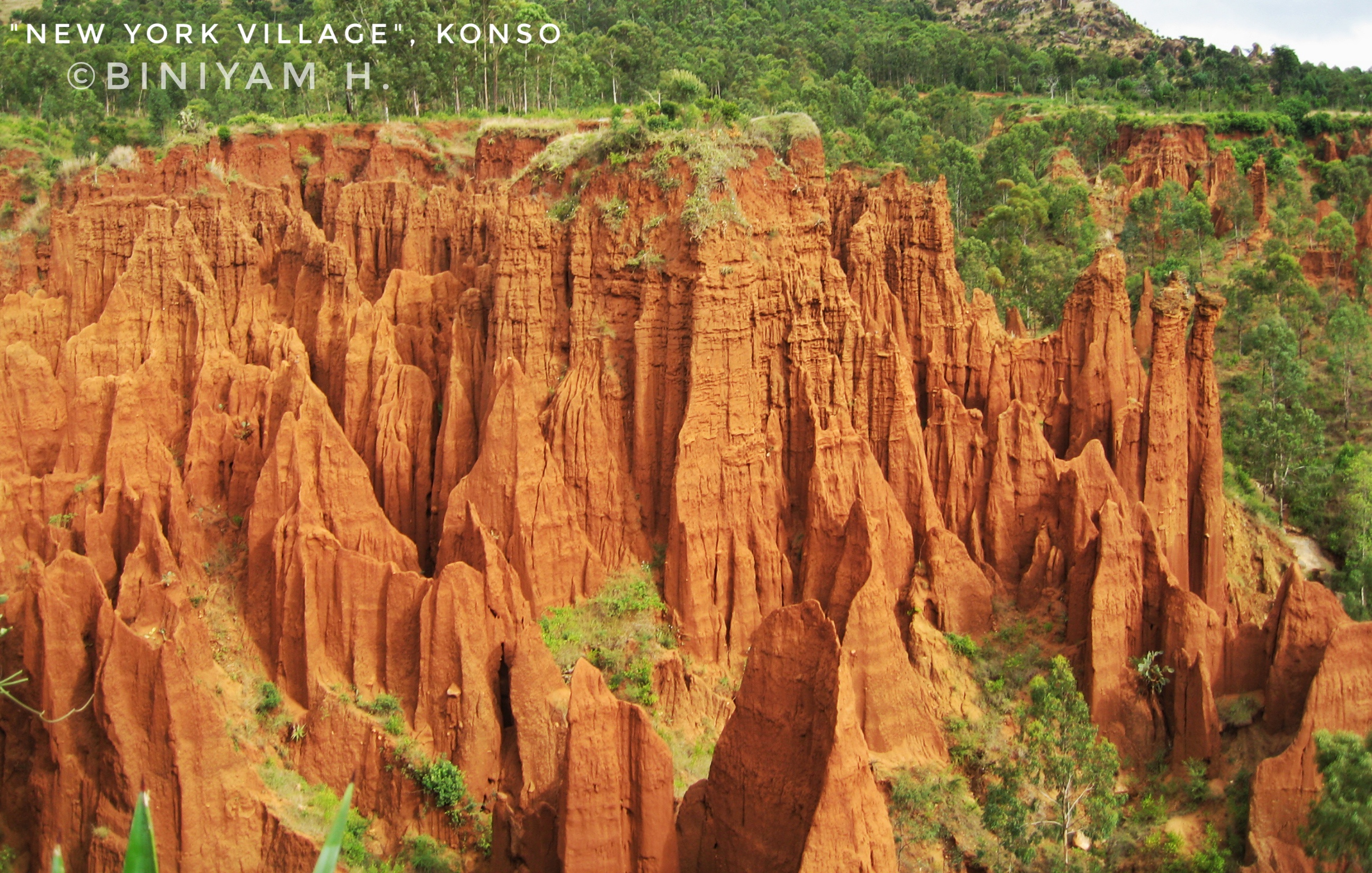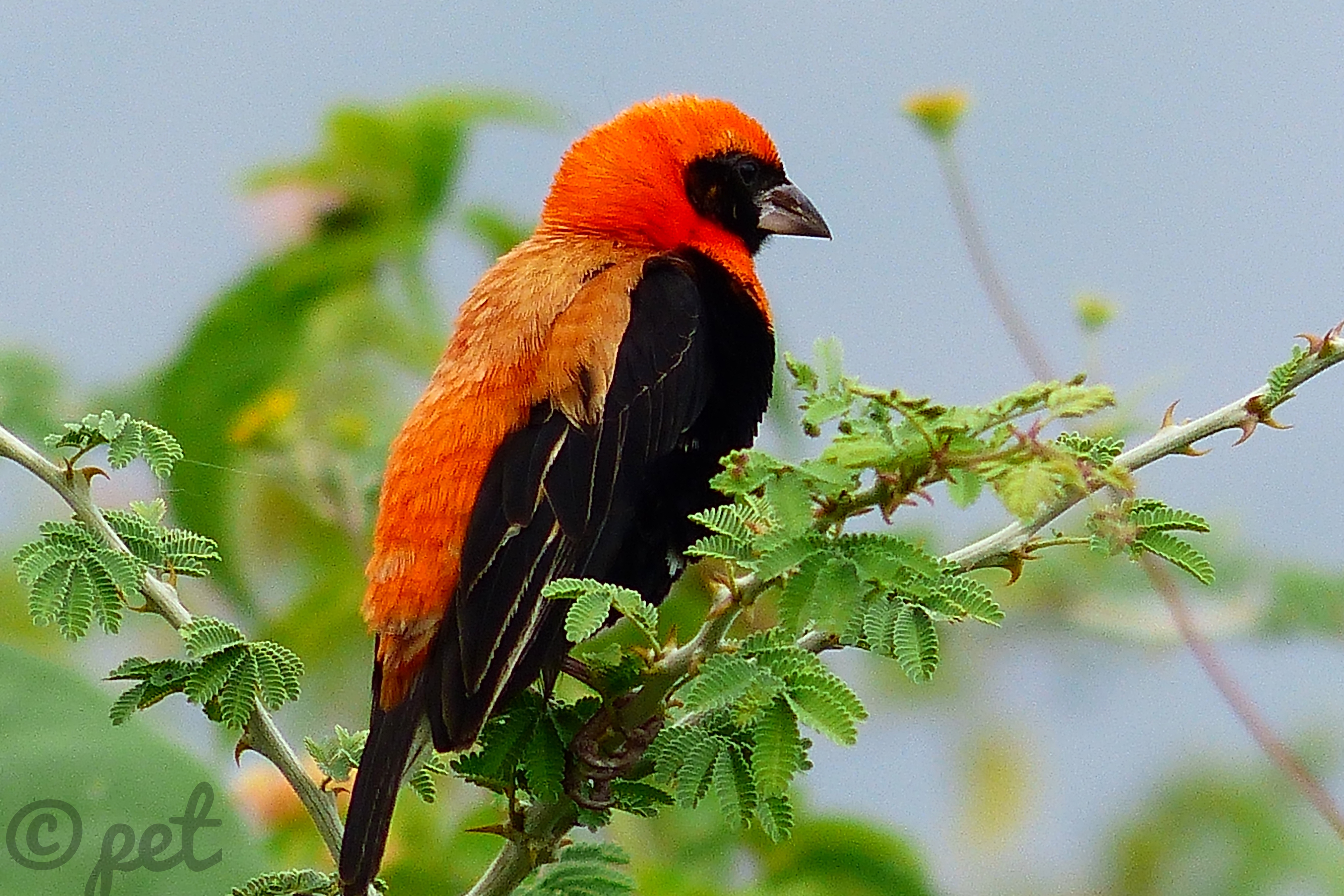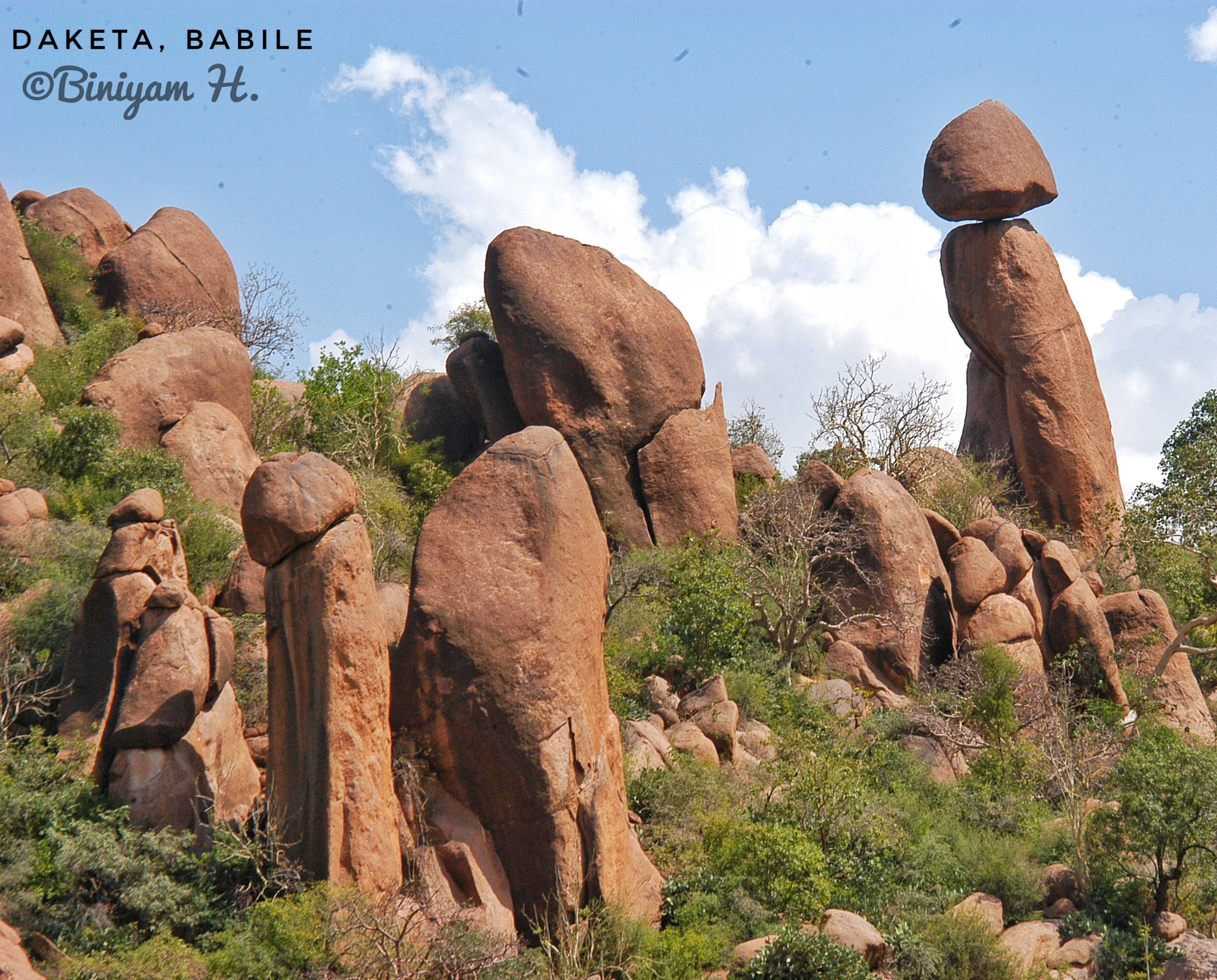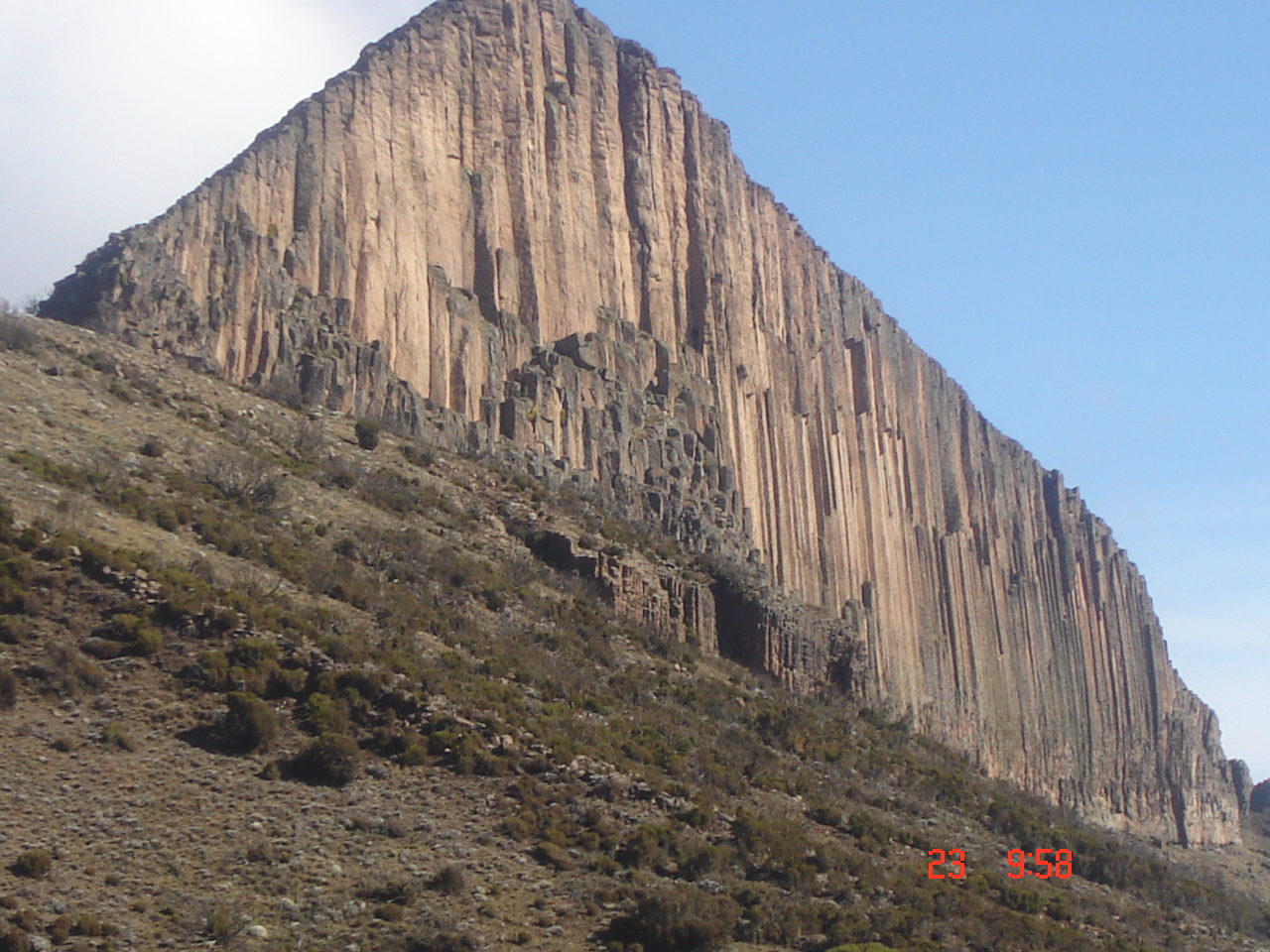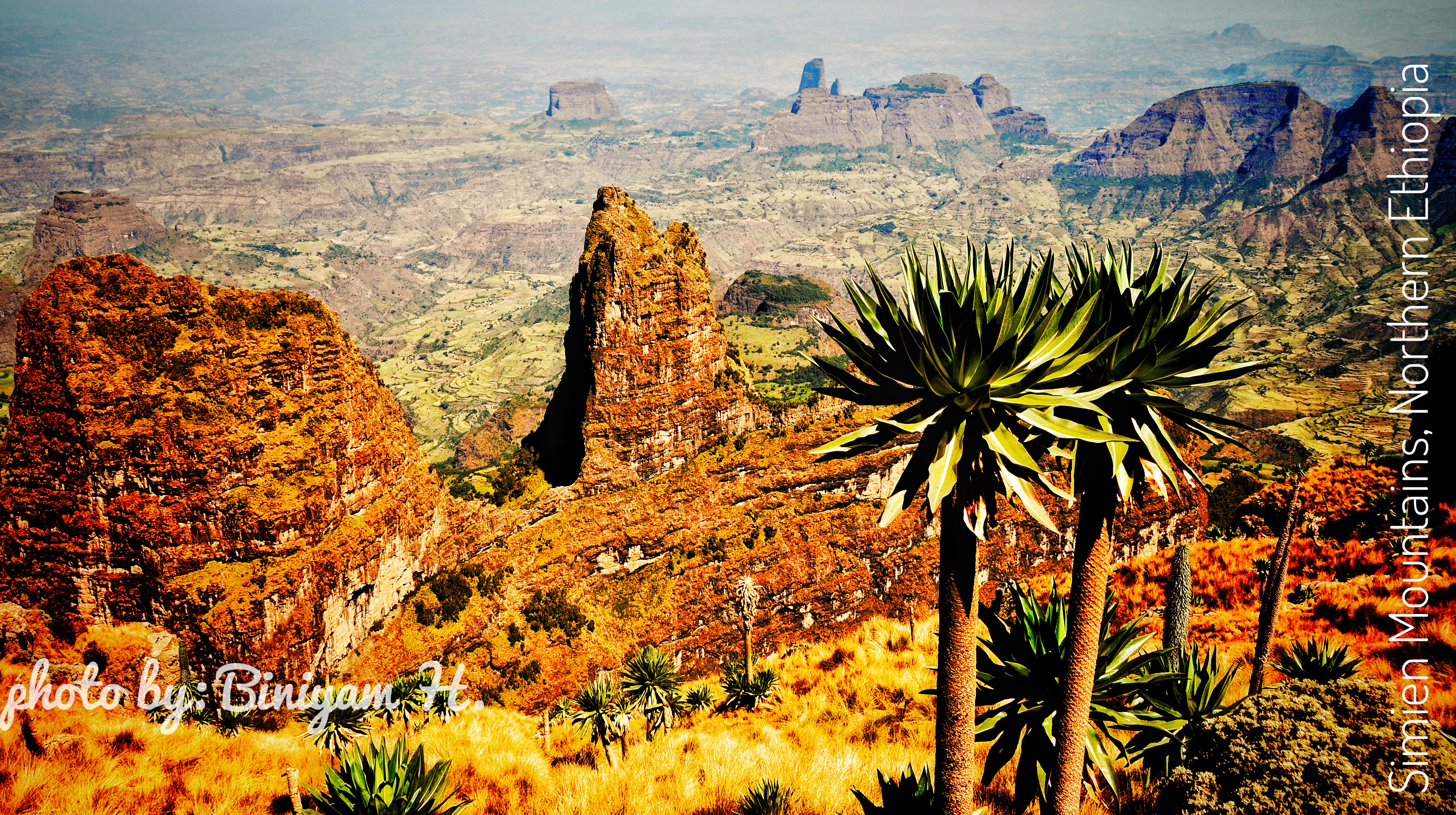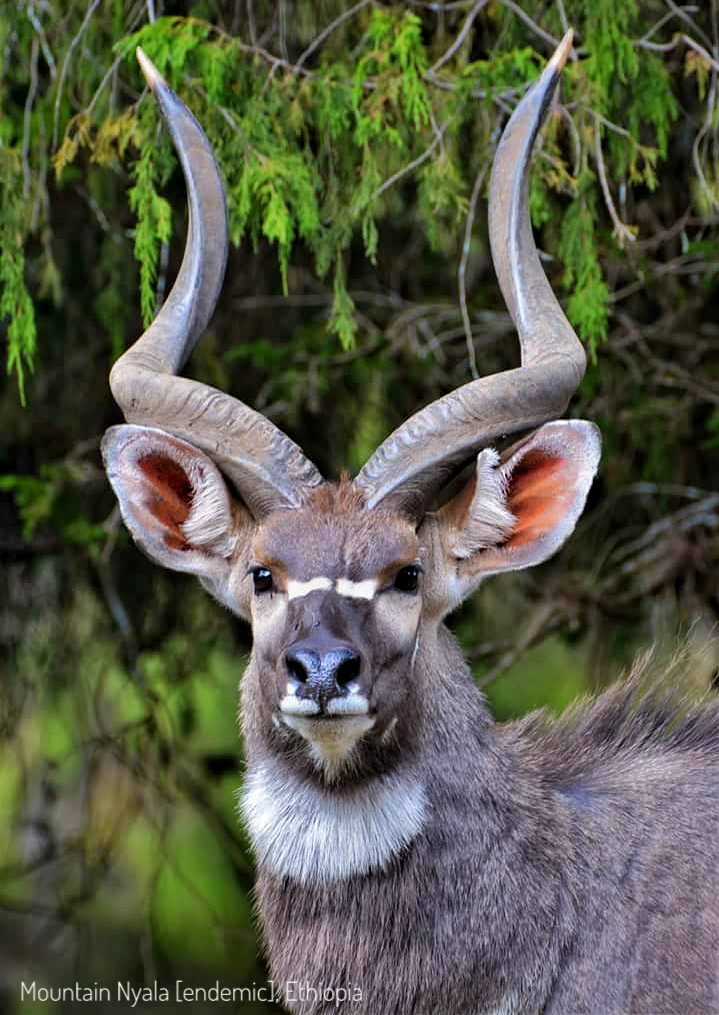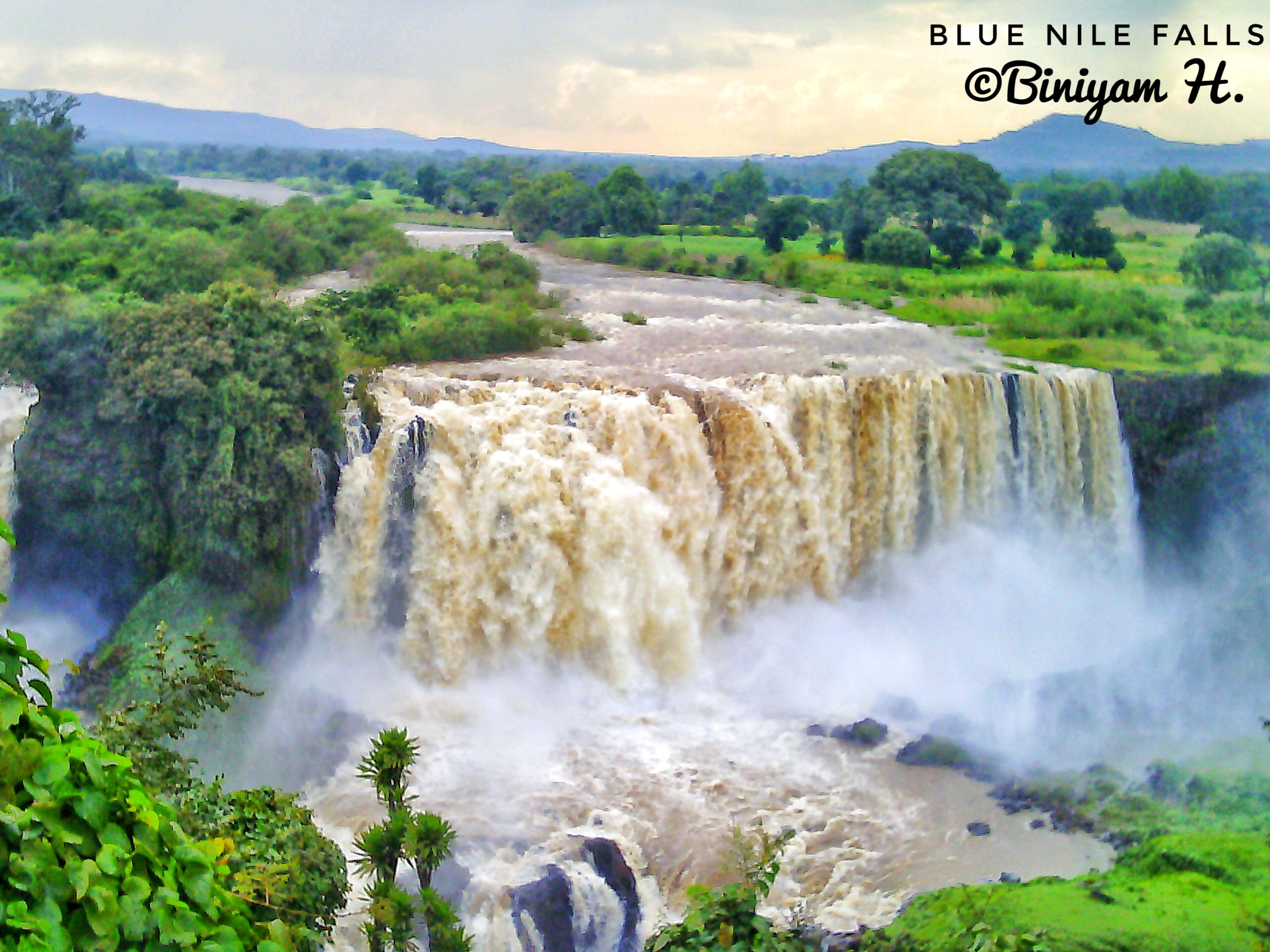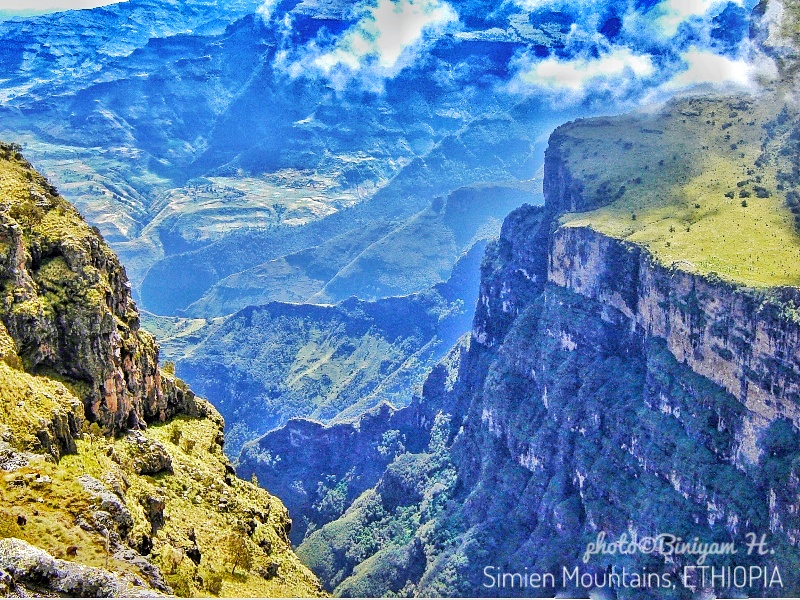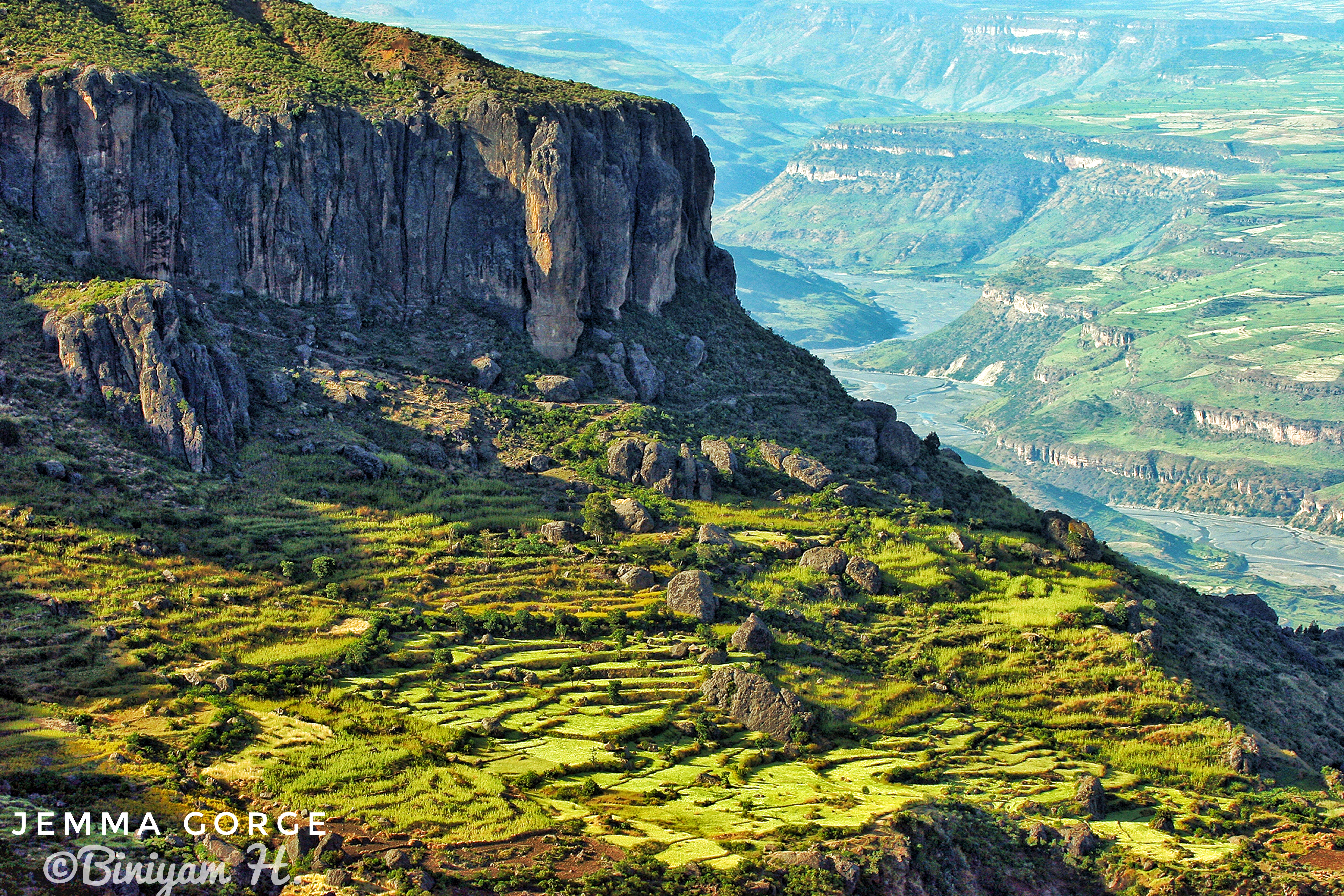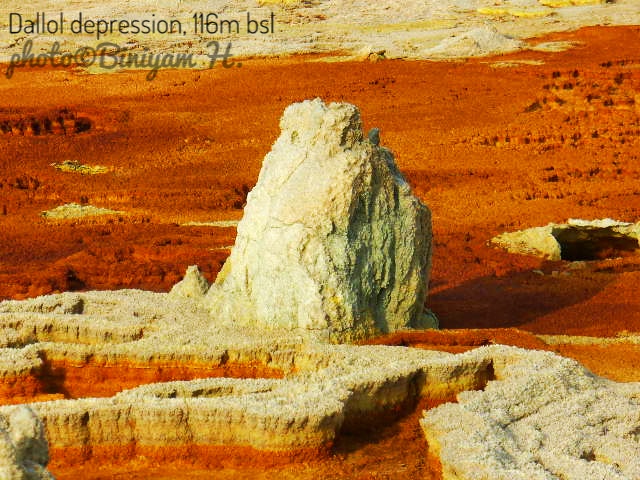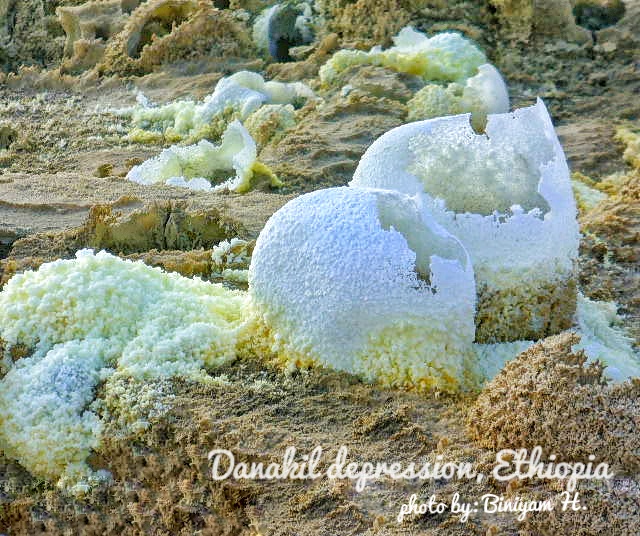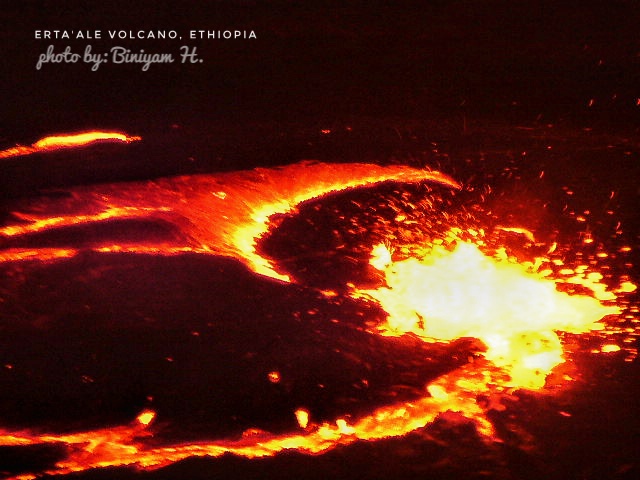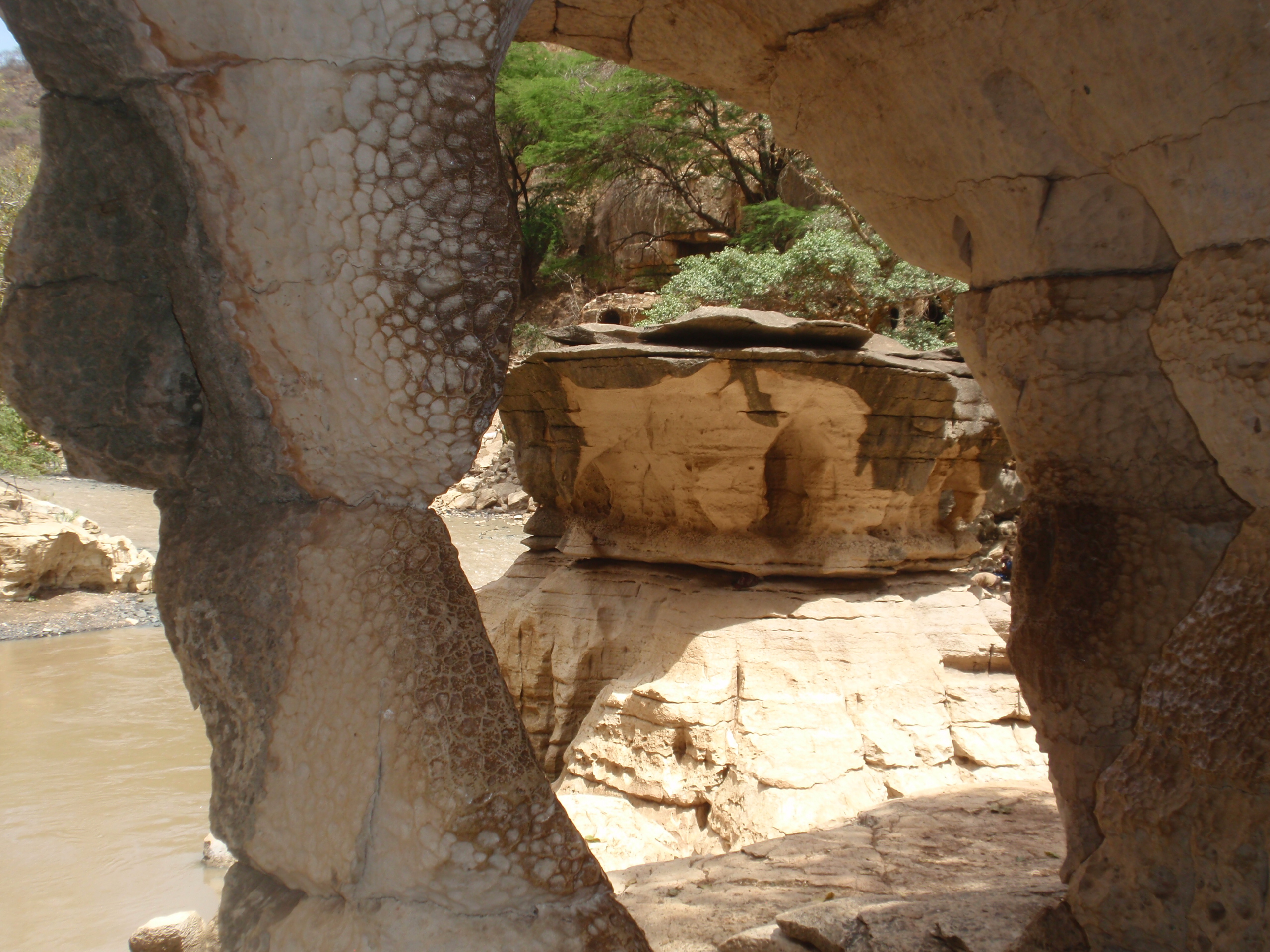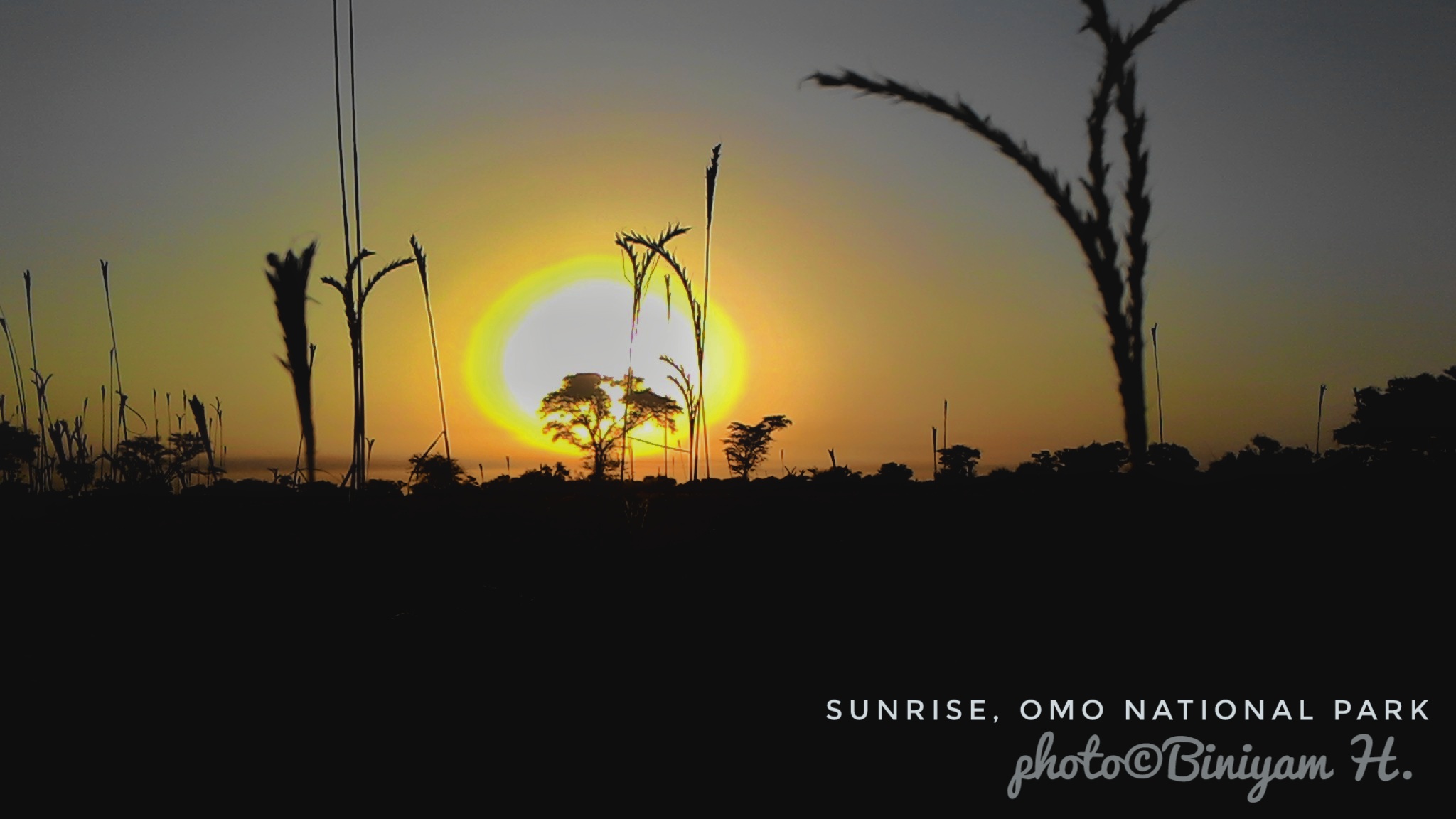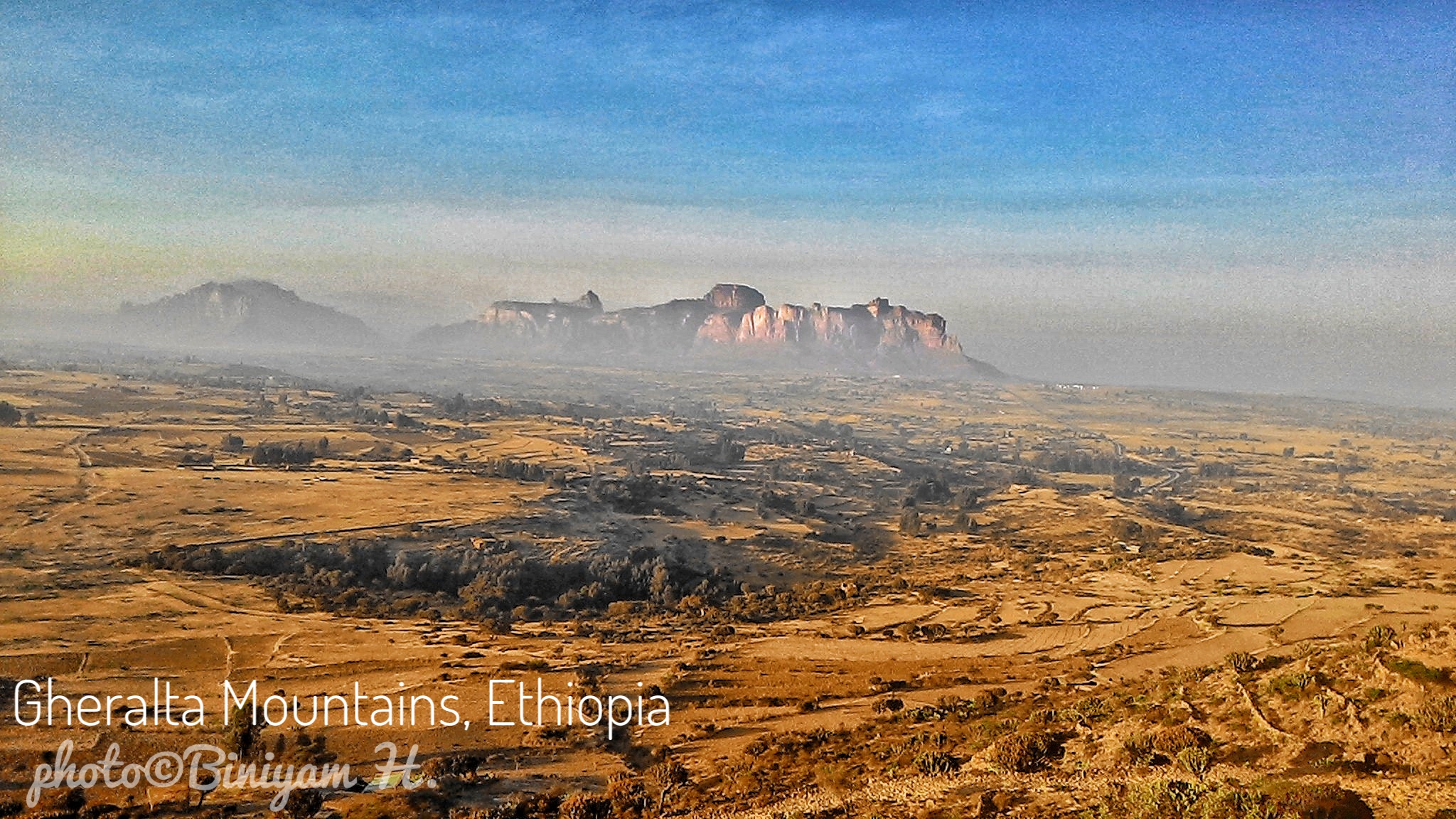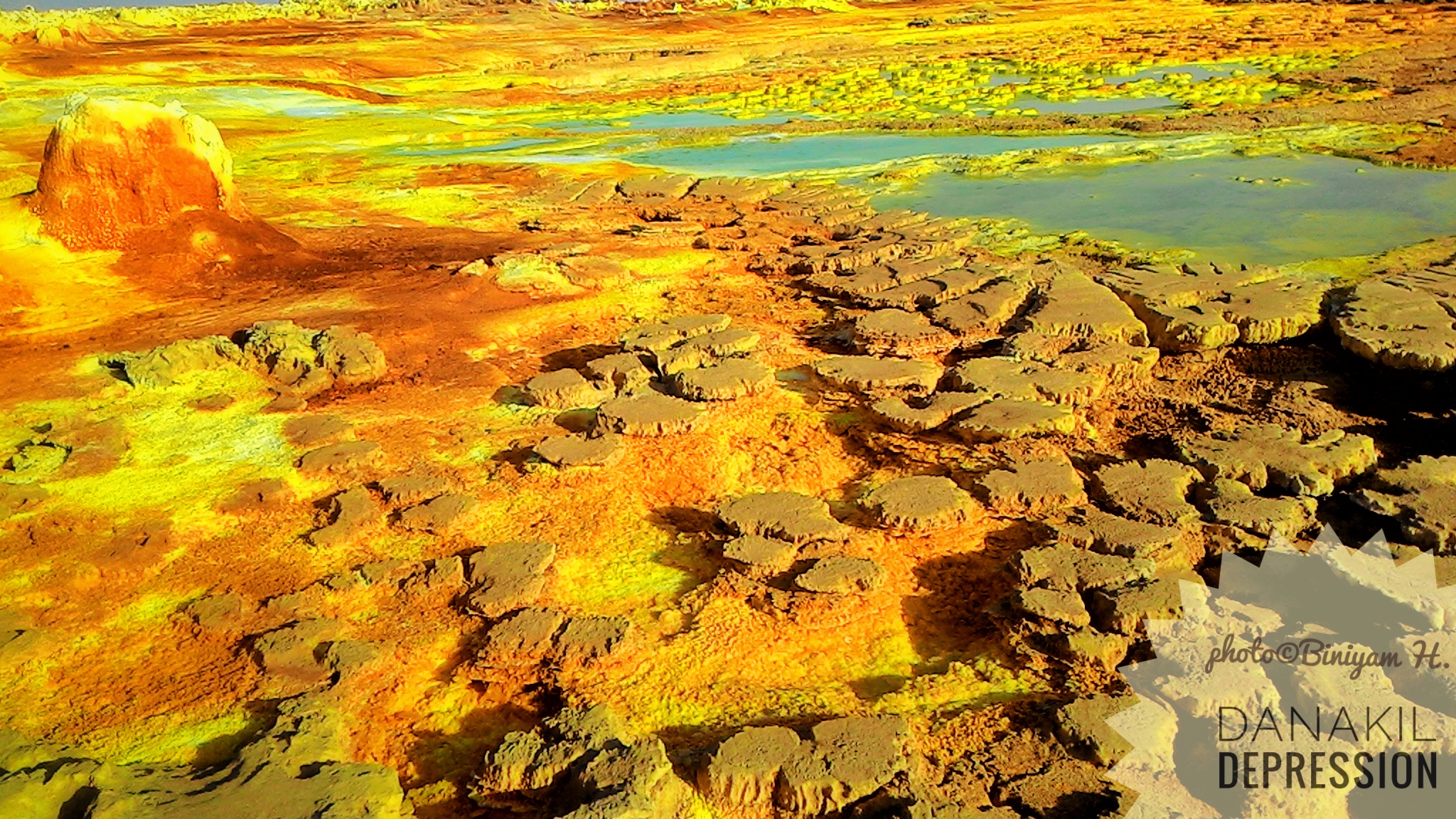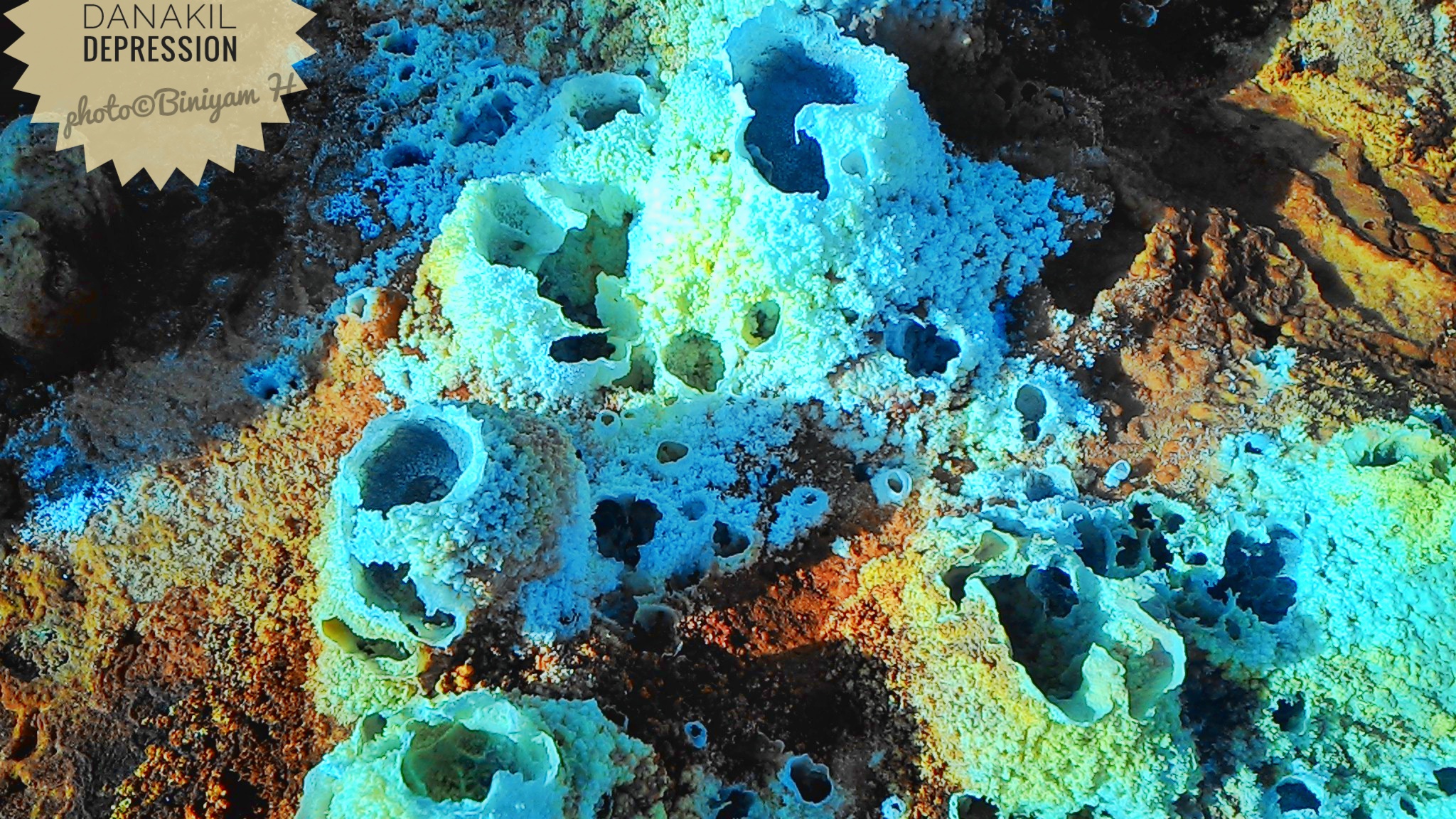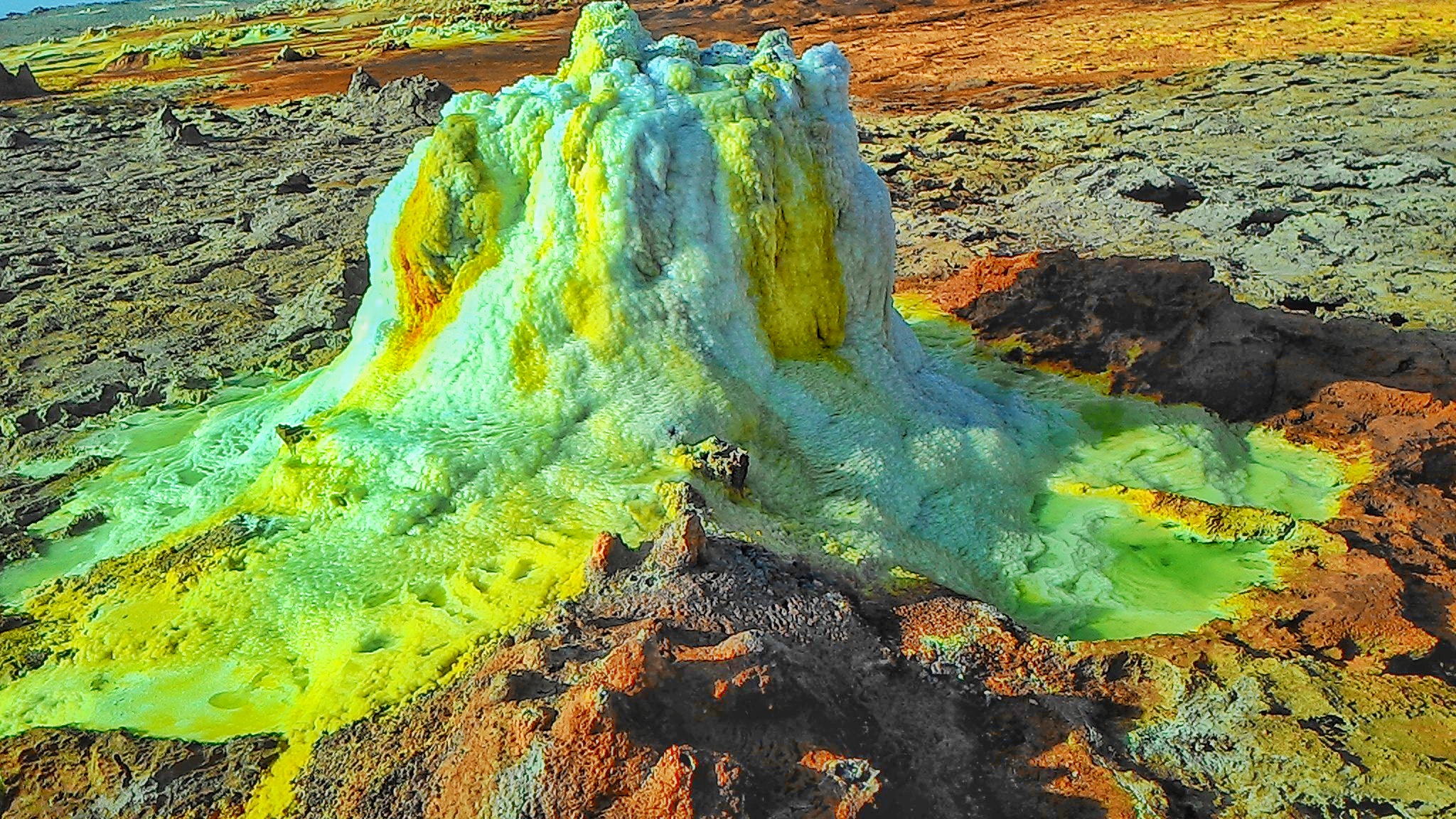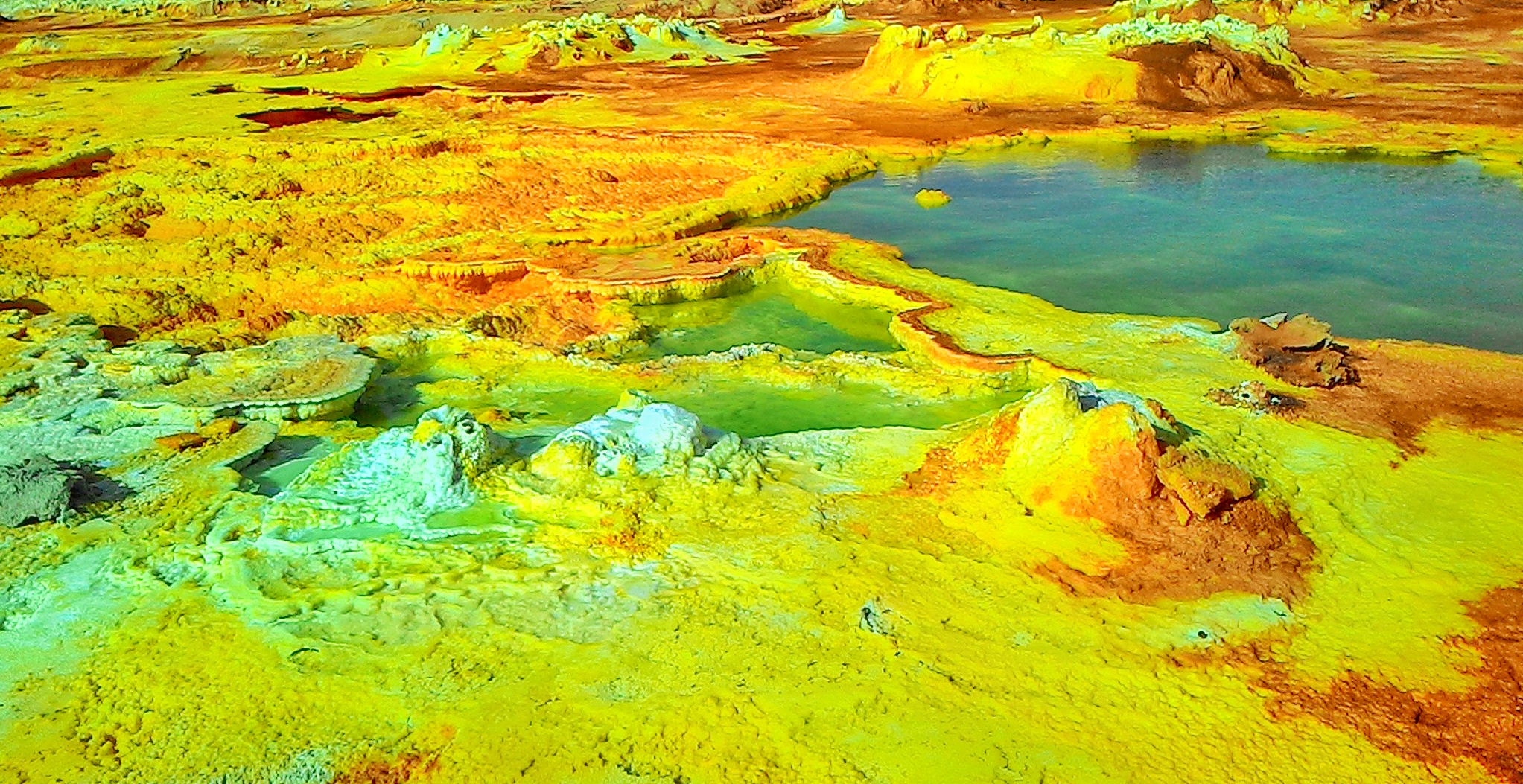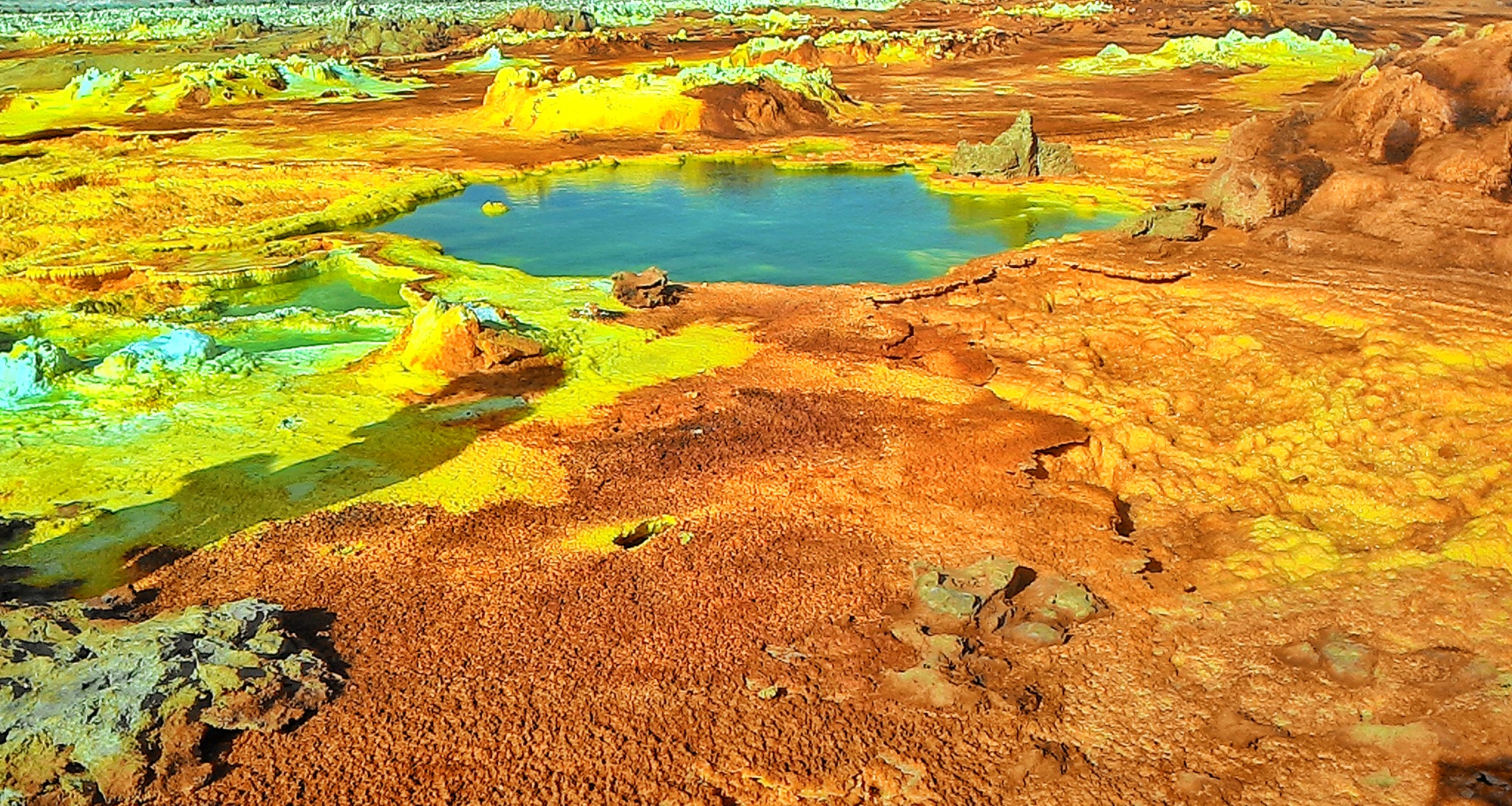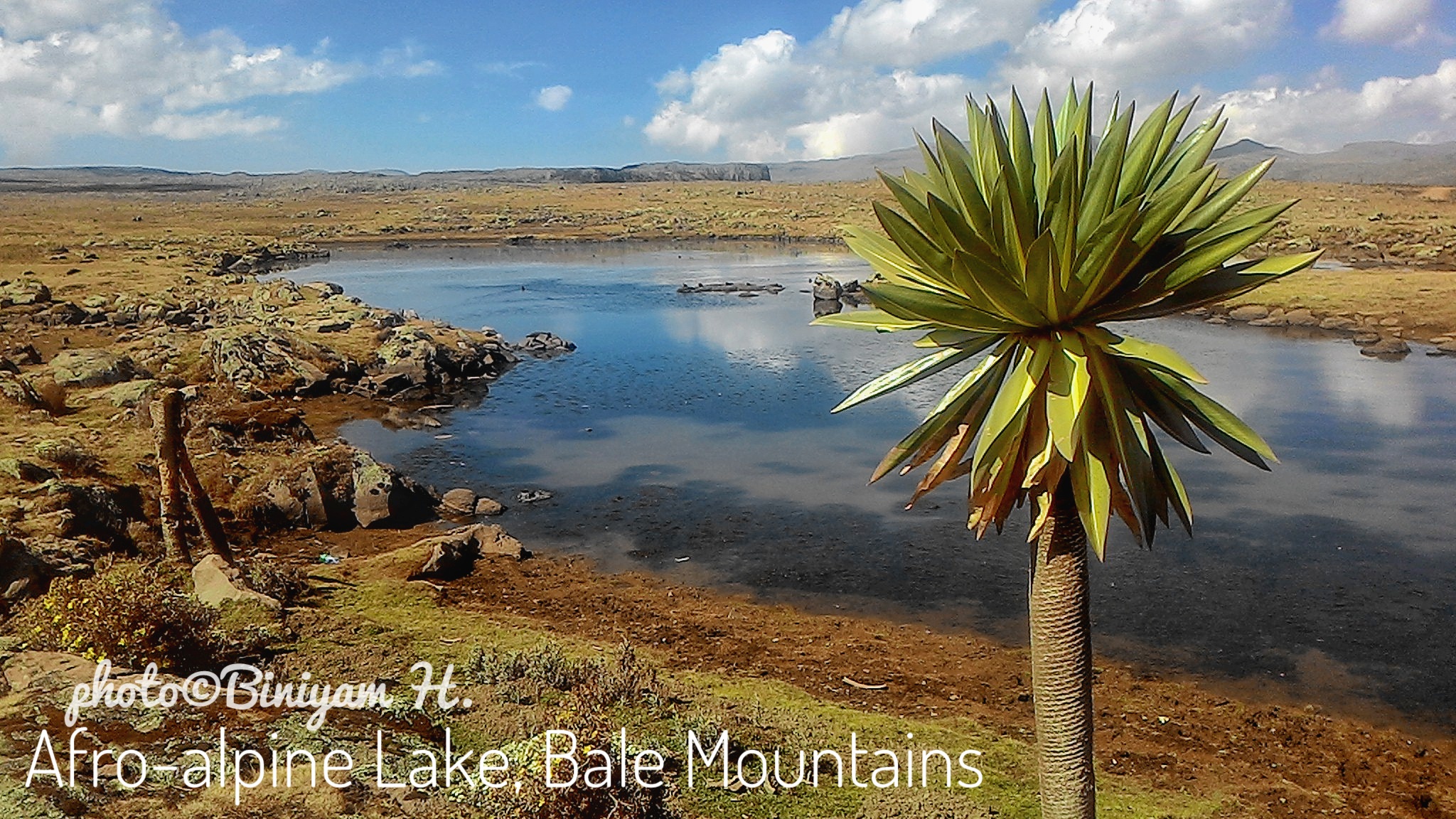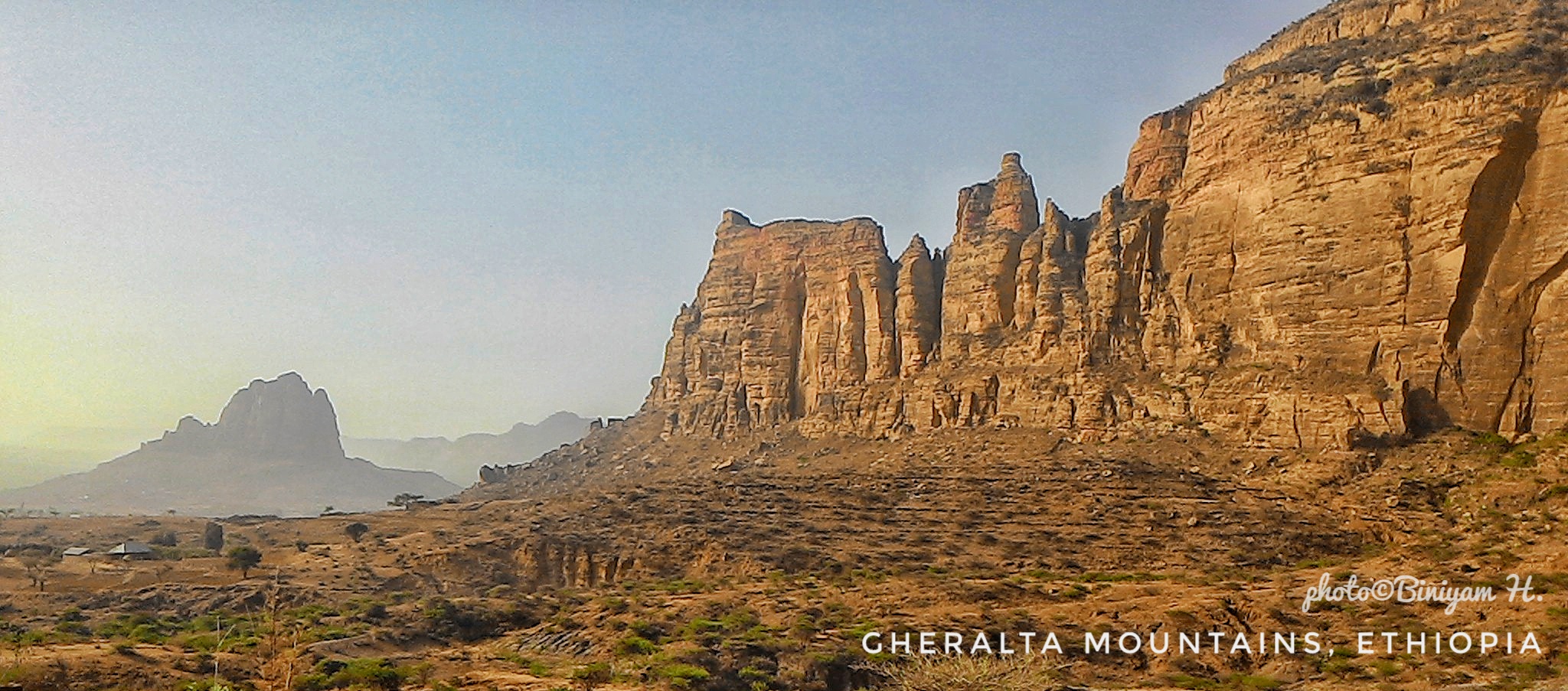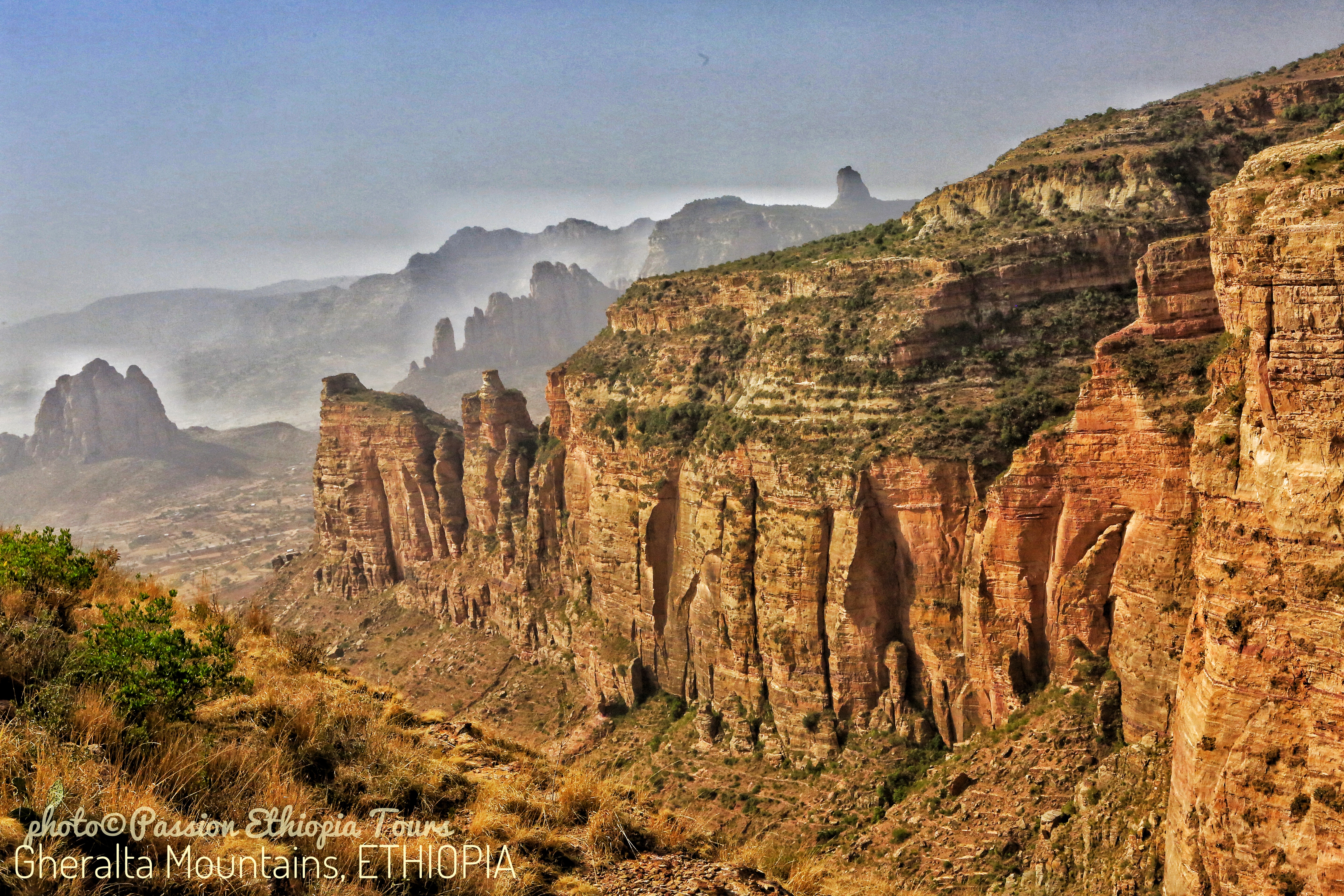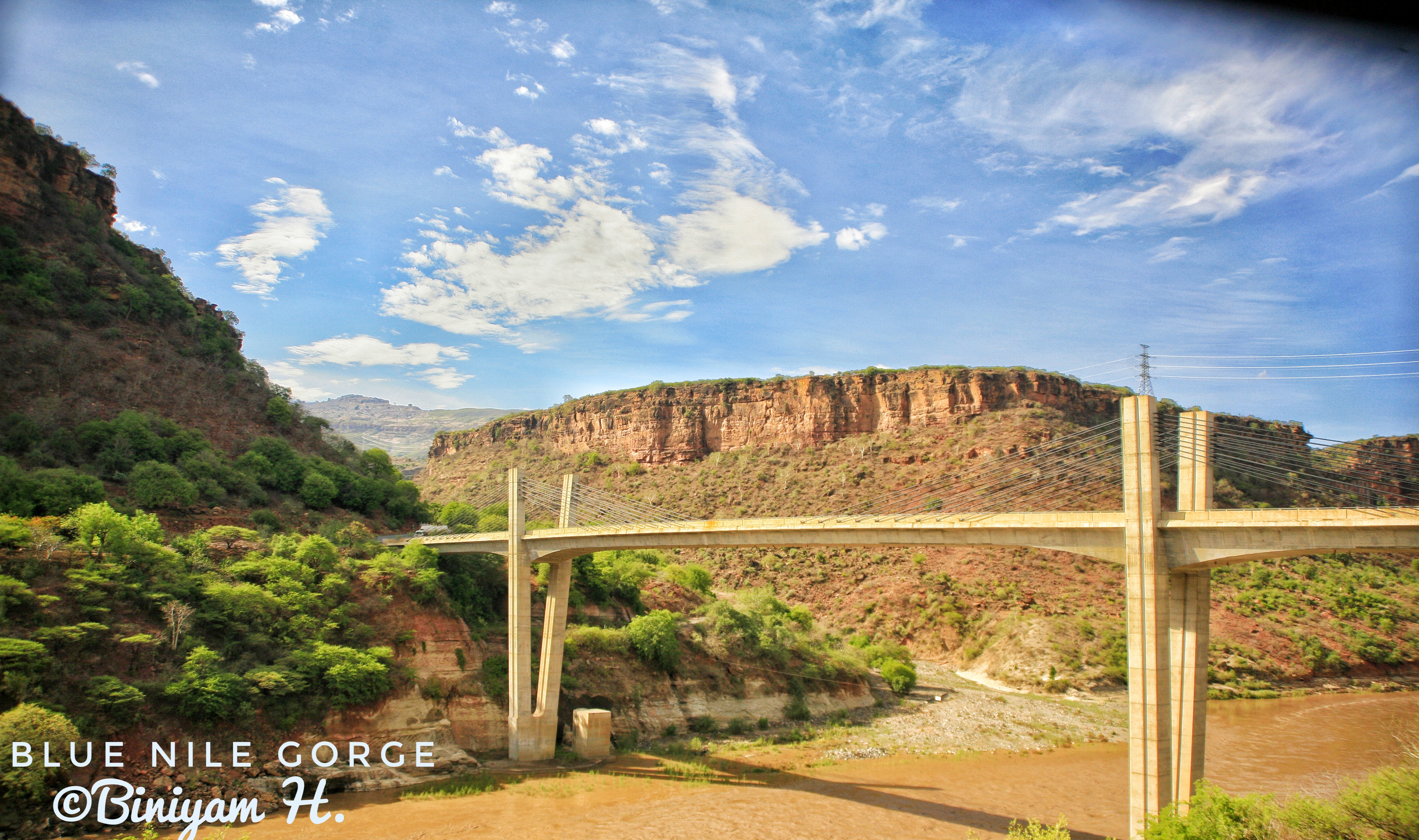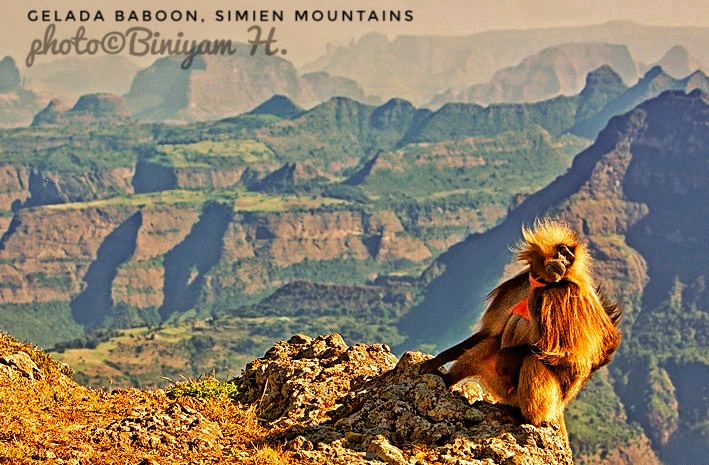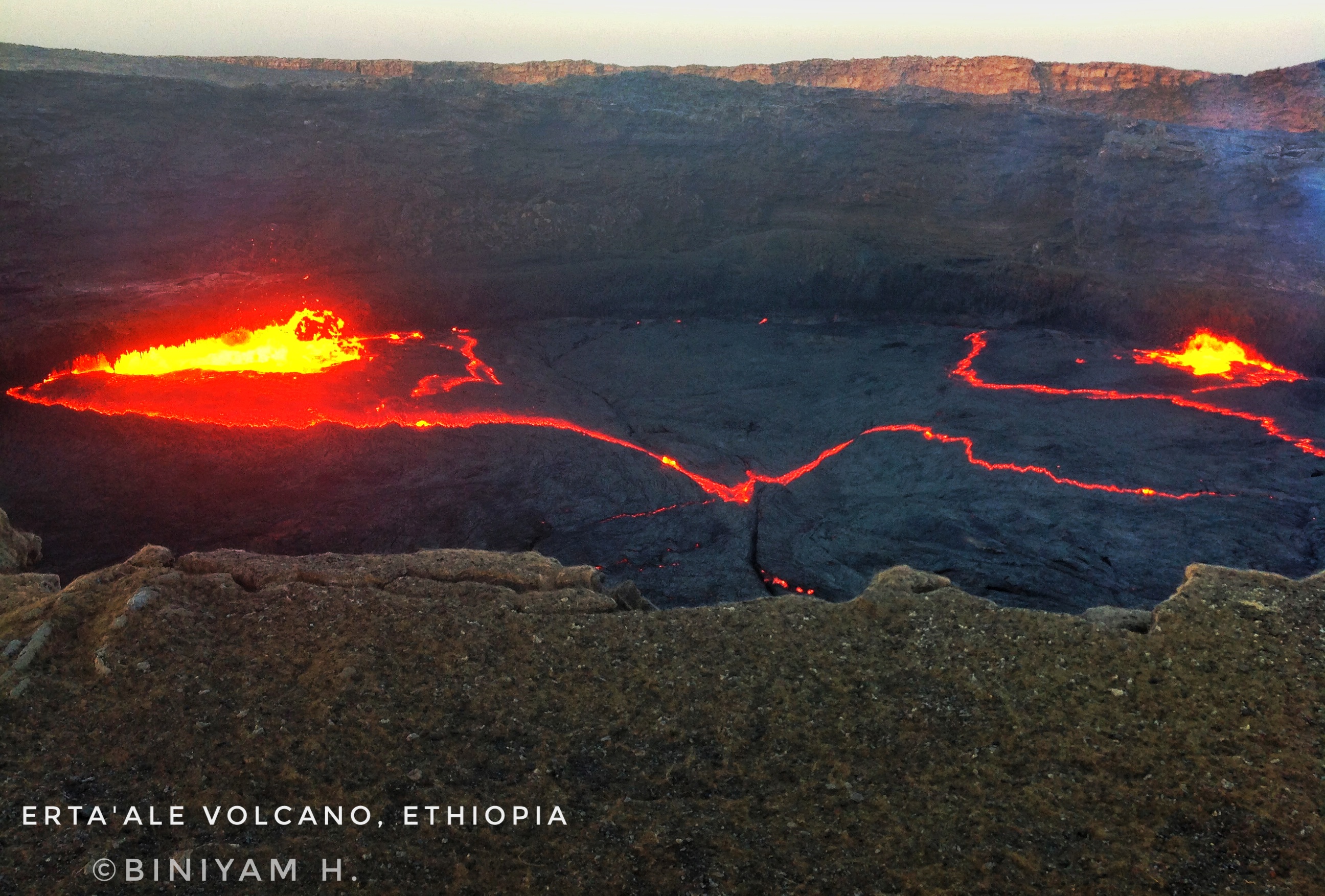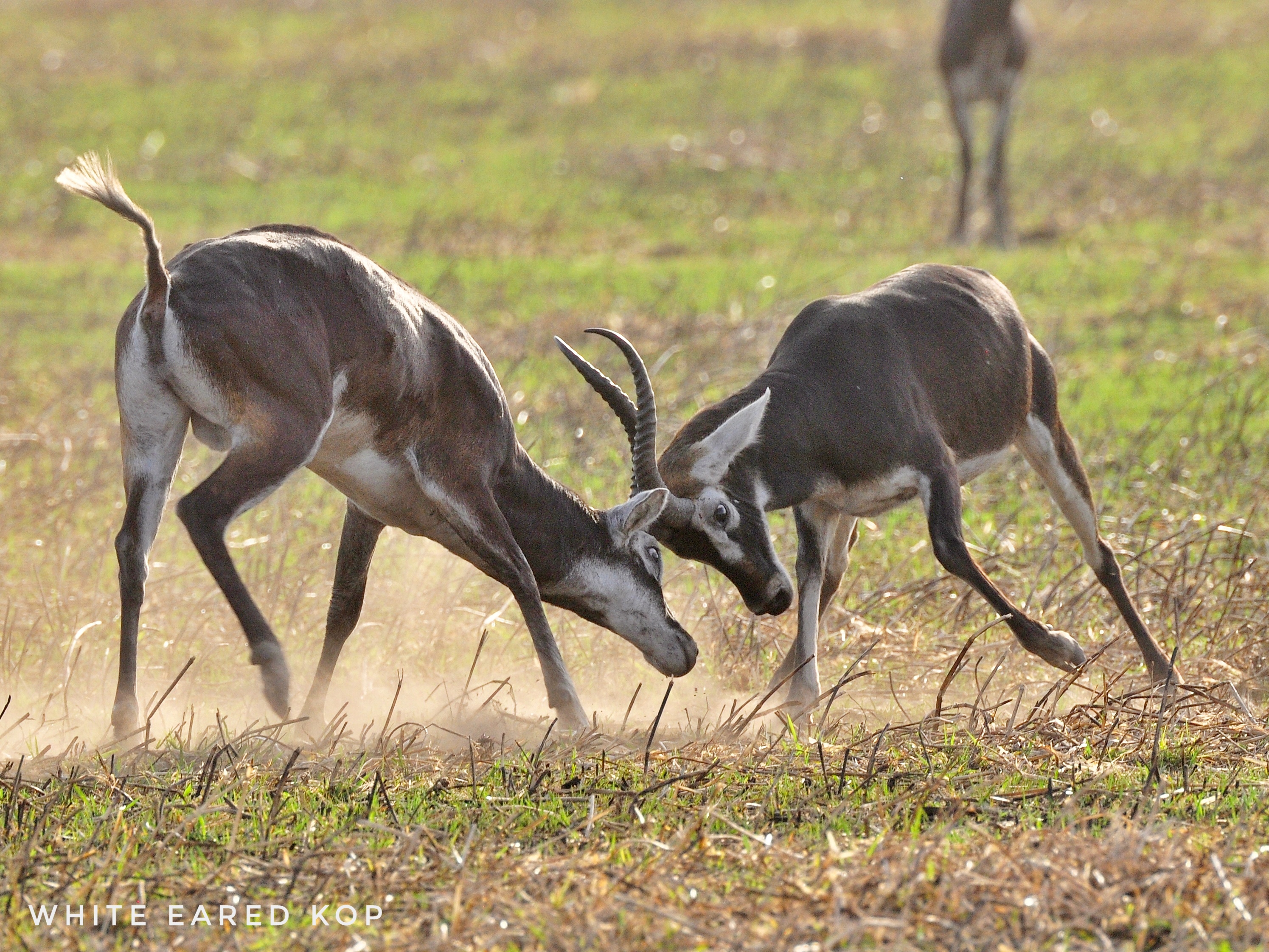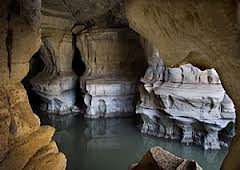Nature
The habitat of the Walia 1bex is the High Semein, Ethiopia's dramatic high mountain terrain. In the earth's long history of violent geographical change, the most recent volcanic upheavals took place in eastern Africa, followed by torrential rains which created the thousand gushing waterfalls which in turn eroded away the newly formed mountain massif, creating the great gorges and gulleys which are so typical of the region. South west of Axum the land descends gradually southwards toward the Takazze River. At the lip of the gorge at about 1,400 metres (4,600 ft.) one can look across the chasm to a similar plateau beyond. On top of this plateau, adorned with steep turrets and bastions rising in three distinct steps, is perched the north wall of the Semyen.
The mountain massif is a broad plateau, cut off on the north and west by this enormous single crag over 60 kms. (40 miles) long and 1,000-1,500 metres (3000-5000 ft.) high. To the south the table]and slopes gently down to 2,200 metres (7,000 ft.) divided by deep gorges 1,000 metres deep and taking two days to cross. Time has not yet been sufficient to soften the contours of the crags and buttresses of hardened basalt. As far as the eye can see looking north from the escarpment, the fused volcanic cores stand starkly defying the elements. Overhead stretches the vast dome of a sky of the deepest blue, which spreads downwards as clear as sapphire to the mauve of the horizon.
In this scenic splendour, lives the Walia Ibex; here and nowhere else in the world. Forced by Man to retreat, and to retreat again, it has been driven in its extremity to inhabit the most inaccessible (except to a bird or a Walia), cliffs of the Semyen escarpment. The Walia once existed in significant numbers probably several thousands in the highland massif, feeding on the cliff faces and coming up to roam the plateau at rutting time. Large herds wandered unmolested on these chilly heights.
Even up to 50 years ago there were well over a thousand. With the Italian agression in Ethiopia, the species started its dramatic decline to the brink of extinction. Guerrillas fighting the Italians and living off the country found the Walia a convenient source of meat. Later, the local people again took i up arms against the Walia, killing perhaps five in order to reclaim the meat from one. Most of them, whose wounded bodies spin and crash from the narrow ledges where they feed, into the abysses a thousand ieet or more below, are never recovered. Rarely, a rope descent will bring to the surface the meat and parts of the skin, but the trophy, the splendid horns desired by locals to make drinking mugs, and by sportsmen to decorate their sitting rooms, are usually lost forever.
First recorded in 1835 by Ruppell, and first properly observed by Powell Cotton at the beginning of the century (l900), the Walia at that time was a mythical beast and little was known of its numbers and status. The inaccessibility of its habitat combined with various historical events such as the Italian occupation and World War II, which made visits to the region out of the question for longish periods, has prevented the keepiug of a continous record since then. So until Leslie Brown made his preliminary study in the early sixties, little was known of its behaviour or habits.
A remnant of the early incursion of Palearctic fauna into the tropics, the nearest relative of the Walia is the Nubian Ibex (C. nubiana). There is a gap of several hundred miles of lowlands between the southern- most limit of the Nubian and the highland habitat of the Walia. The Walia differs in being 1arger and more massive, with dark brown as opposed to pale brown fur. The horns of the males are more massive but not quite so long, and have the knobs or ridges on the anterior surface reduced. The Walia has a bony process on the forehead. The anatomical differences together with the differences in habitat have lent weight to the argument that the Walia is a distinct species.
The terrain which the Walia inhabits is from 2,300- 4,000 metres (7,500-13,500 ft.) but chiefly above 2,500 and below 3,000 (8,000-9,500ft.). The tiny remnant population which remains is now con- fined to a range of about twenty miles of the highest and steepest bays and buttresscs of the northern escarpment. They are already extinct in all other parts of their range which once stretched from Byeda along the escarpment to Geech and Adis Gey.
The narrow vertical range which they tend to occupy today would seem to be the result of persistent hunting. They have become extremely wary and shy and chosen to be not get-atable from top or bottom. With protection maybe they will once again emerge on to the plateau.
Mountain sheep and goats have feet that are special- ly adapted for living in mountainous terrain. Their hooves have sharp edges and the undersides are concave, enabling them to adhere somewhat like suction cups. To watch even the youngest and smallest of the Walia kids gambolling about on slanted rocky ledges in a cliff face of terrifying steepness, a 500 metre drop only inches away, makes one catch one's breath with anxiety. They never fall.
The males and the females both have horns, but the males' are more massive. Curving back in a graceful arc to the withers they sometimes attain a length of over 110 cms. The females are smaller in body and lighter in colour with shorter thinner horns. They live in small parties of two to half a dozen and the big old males often live solitary except during the mating season. Because of the rarity of the animal, it is not often possible to observe a large male and one feels privileged to do so. The magnificent horns and striking colouration make it an unforgettable sight.
They are sturdily built animals standing about a metre high at the shoulder and weighing up to 120 kgs. Their beautiful chocolate to chestnut brown coats shade to greyish brown round the muzzle, paler grey around the eyes, lower flanks, legs and rump, and pale grey or white on the belly and inside of the legs. There is a black stripe down the outside of the legs and a white garter on each fetlock broken in the hind legs by a black streak into the cleft of the hoof. Mature males sport an elegant black beard. The tail is short with a brushlike tuft of black hairs.
You can usually observe them when come out on to the rocky ledges to sun themselves in the morning and evening. Little herds of females and young are not uncommon, or even single females with a kid at foot. Sometimes you will see a yearling group of young males which can be distinguished by their paler greyer colour and the thickness of their small short horns. They eat grass and herbs, but prefer to to browse rather than graze, standing up on their hind legs like domestic goats to reach the tender shoots of giant heath. There is no shortage of food, as inside the forest of heath there is abundant forage of herbs and sweet soft grasses. They tend not to drink although water is plentiful; it is assumed that they get sufficient moisture from the green stuff on which they feed. They usually lie up in caves or thickets during the day, although this is not an in- fallible rule and I have observed them at lunchtime - a group of youngsters playing in the sun.
The Walia's story is not yet ended. In 1963 it was classified by the IUCN as in danger of extinction. In that year the total number remaining alive was estimated at less than 200, probably 150. Indiscriminate hunting and destruction of habitat by local people had combined to drive the few remaining animals on to the vertical cliff sides for survival- (Only four adult males have been taken since 1956 by legitimate shooting). Fortunately before the end came the Ethiopian Government recognized the danger and, in 1965, drew up plans to establish a national park to protect both the habitat and its fauna, and the park was gazetted the same year. It was found that numbers had remained steady for two years, indicating that with protection they might increase fairly rapidly. Guards were appointed from Geech to Mietgogo to curb local poaching and illegal cultivation and burning of habitat. In the past fifteen years, numbers have increased steadily, as the females are still ready and willing to breed in the caves in the cliff face.
At the present time, not less than 10% of the cliff surface is composed of broad ]edges or green gullies in which Walia can feed. Brown estimates that this amount of land space can support a population of two or three thousand. The Walia has no natural enemies apart possibly from the occasional bird of prey, and thus with complete protection from Man they could be expected to recover their numbers and to double the present population in ten years.
At present it is still difficult to properly enforce the protection laws, and the local people cannot be expected to know that this animal exists only here. Nor could they realize that it could be anticipated to generate a far larger income if allowed to live and breed, than its dead parts will ever earn. It can only be hoped that the precipitous terrain in which the last survivors live will enable a nucleus herd to survive until such time as visitors from all over the world will be able to come and observe this rare creature in the magnificence of its mountain habitat.
Menelik's Bushbuck
(Tragelaphus seriptus meneliki) Amharic: Dukula.
Belonging to the same family as the Mountain Nyala, the Kudu, the Bongo and the Eland, the bushbuck shares with them the family characteristic of shy and elusive behaviour. Over forty races of bushbuck have been identified, which vary considerably both from the point of view of colouration and from the type of habitat they frequent. Most of them are forest- living animals inhabiting dense bush, usually near water, though this is not an essential, as some of them have been known to go without drinking for long periods when necessary.
Of the two Ethiopian races, meneliki and powelli, the latter is the more common and somewhat smaller. But Menelik's is also fairly widespread and can be seen in much of Ethiopia's highland forest up to the treeline at 4,000 metres (13,000 ft.) They are com mon, for example, in the cedar forests of Menagesha and parts of the Entoto range, even ir, eucalyptus groves as long as there is still some ground cover. No accurate estimate has been made of their total population because of their nocturnal and furtive habits. Like the Mountain Nyala, they are easier to observe in the Bale Mountains National Park where they are fully protected and therefore a little less shy. Powelli inhabits the lower lying country, so between them they cover almost all types of habitat, from highland forest to savanna woodland - with the exception of open country.
In Bale, as you climb up through the hagenia forest with its flowering trees, and enter the zone of Giant Heath and St. John's Wort, sunlight dapples the ground beneath your feet, lichens hang softly from every twig and bright dark green mosses clothe the branches. Suddenly a glimpse of bright chestnut draws your attention to the female bushbuck, and usually not far away is the shining dark, almost black, male. Bushbucks are often solitary, but in Bale anyway, Menelik's is almost always seen in pairs or small family parties of female and young. They are extremely beautiful little animals, with a coat longer than that of other bushbucks, perhaps because of living in the lower temperatures of high altitudes. The horns, which are carried only by the male, have a spiral twist and a well-defined longitudinal ridge or keel on the front or back surfaces, and transverse rings. The record horn length is 34.93 cms.
They stand 80-90 cms. (35 inches) at the shoulder and slightly higher at the rump, running along in a hunched up manner between the bushes and shrubs. They have large broad ears and when they stop to regard an intruder the ears with their tufts of white are conspicuous. A spinal crest of longish white or black hairs runs down the centre of the back. A white spot on the cheek, and on the female sometimes a blackish collar on the lower neck, faint white spots on the haunches, and limbs with a contrasting dark and light pattern. The tail is bushy and long, reaching to just above the hocks, white underneath and black- tipped.
Most bushbuck tend to spend the heat of the day lying up in dense bush where there is no hope of spotting them. The highland forest where Menelik's bushbuck lives, is relatively cool and you can see them (if you are in luck) at any time of day. It is more usual however, to spot them from about four o'clock onwards, or in the early morning. They have a loud barking alarm call, sometimes repeated, which can be heard from some distance away, and also a series of grunts. Very few Menelik's have been collected by sportsmen. The multiplication of numbers in the park could lead to its greater accessibilty to authorised huntsmen, and produce an income for conservation.
Mountain Nyala
(Tragelaphus buxtoni) Amharic: Dega Agazain
The Mountain Nyala was the last of the great African antelopes to become known to science, and still today very little is known about its habits or the full extent of its range. It was first collected by Major Ivor Buxton in 1908 and at that time seemed to be fairly widespread throughout the Arsi and Bale regions. Large numbers of them lived at very high altitudes, between ten and thirteen thousand feet, in the mountain forests where it was cold and wet much of the time, until the pressure of the human population destroyed vast tracts of their forest habitat. In Arsi the population is now reduced to a remnant.
Fortunately in Bale, despite a certain amount of burning of the heath, great tracts of mountain giant heath forest and hagenia were left unspoiled and the Nyala were never seriously threatened with extin- ction. They were so much hunted that they became even more wary and shy than is their nature and one rarely caught more than a glimpse of them as they melted away into the bush. The creation of the Bale Mountains National Park has considerably altered this picture. Here, where they are fully protected, they are beginning to be much more confident, and one can see them readily, especially in the mornings and evenings when they come down in to the hagenia forest on the lower slopes to graze. They are breeding prolifically and comparatively large groups of females and young can be seen.
Nyala are a magnificent sight, particularly the old bulls with their fine spiralled horns. Females do not carry horns and they have rather long necks and large ears, which are very conspicuous. The body colour of an old male is dark grey, with a line of long hair along the back forming a straggly mane which continues' along the spine as a brown and white crest. Young calves are bright rufous and can be mistaken for bushbuck if the mother is not seen. Females are redder that the males, although they tend to become greyer with age. They move in parties or small herds of about five to ten females, and although the really old bulls are solitary and not often seen, young adult males carrying quite impressive spreads of horns, can sometimes be seen with or near the herds of females and young, and males are sometimes seen in small groups of two or three individuals.
There are white markings on the legs and two white spots on the face, a white chevron between the eyes. Nyala are similar to Greater Kudu but can be distinguished by the single spiral horns and the absence of clear white stripes on the body. Those of the Nyala are only faintly visible, and with a few faint spots on the flanks. It can however, be thought of as a high altitude race of the kudu.
lt stands 135 cms. (53 inches) at the shoulder and weighs some 200-250 kgs. (440-550 1bs). An old bull reaches 300 kgs.(660 Ibs). It has two white patches on the underside of the neck; the upper very wide and the lower one crescent-shaped. The back and upper flanks have about four white ill-defined stripes and a few white spots on the thighs. The tail does not reach to the hocks, it is bushy with a white underside and black tip.
During the hottest part of the day, Mountain Nyala lie up in some shady place generally in the giant heath zone. They often choose a place where anyone approaching gives them warning by stepping on dried bracken or twigs and they then disappear in an almost miraculous way - not to be seen again. The best way to observe them is to select an inconspicuous spot and sit quietly until about four in the afternoon when they leave the giant heath and come down among the wider-spaced kosso trees.
The Nyala is not an endangered species - there is a population of four to five thousand animals in the Bale region and they are breeding strongly. In fact, it may well be necessary to cull some of them by controlled hunting in order to prevent them destroying their own habitat by overbrowsing and breaking tracks through the undergrowth of the forest cover. Licensed hunting also brings in revenue to the Wildlife Conservation Organization. Old bulls with trophy heads (horns over 88 cms. (35 inches) are fairly rare) are a true sporting challenge to the hunter.
The Bale Park protects and preserves a representative section of forest and mountain unique in Africa and of spectacular beauty, as well as Ethiopia's finest antelope.
Swayne's Hartebeest
(Alceluphus buselaphus swaynei) Amharic: Korkay
The common African hartebeest has fifteen races of which two are already extinct and Swayne's is seriously endangered.
In 1891-2, Brigadier-General Swayne, who discovered the animals, was the first European to visit the area well south of the Golis range of Somaliland and about 200 kms. (125 miles) from the coast. The plains were described as "covered with hartebeest, 300-400 to a herd and a dozen or so herds in sight at any time"- Herds of a thousand individuals were observed. Within fifteen years the tens of thousands in Haud and Ogo that Swayne had seen had dwindled to such an extent that he estimated only about 880 remained. This rapid decline was due to the rinderpest, which swept Africa during the last century. The Somalis "went out daily and pulled down the sick animals with their bare hands in order to take the hides". Military campaigns followed in which the armed forces were permitted to kill as much game as they wanted. Arms flowed in and in the unsettled conditions which prevailed hunters very efficiently, and in a very short time, had almost succeeded in wiping out the remnants of the Oryx and Hartebeest herds in the area.
Hartebeest are almost grotesquely long-faced and have high withers and sloping hindquarters. The horns, carried by both sexes, are doubly curved and mounted on a pedicle. Some authors still consider that according to the shape of the horns, which is supposed to be the most important diagnostic character, each race of hartebeest should enjoy full specific rank. However, the presence of hybrid forms has led zoologists to regard them as a sub-species, and it is now generally accepted to classify them as geographic representatives of the same species.
Three types of horns can be distinguished in the buselaphus group:
U-shaped as in the now-extinct North African buba hartebeest, and in the western hartebeest from Gambela, Nigeria and Cameroon; V-shaped as in the Lelwel Hartebeest (A. buselaphus lelwel), Jackson's Hartebeest (A.b. jacksoni), and the South African cape hartebeest (A.b. caama), (all of which have very long heads and a uniform red-brown colour). The third type of horn is shaped like inverted brackets as in Coke's Hartebeest (A.b. cokii), in the pale tawny A.b. tora from Sudan and Ethiopia, and Swayne's Hartebeest, previous]y found in both Somalia and Ethiopia, but now restricted only to Ethiopia.
Swayne's is the eastern race of tora to whom it is closely related, both species being smaller than the uthers, but is distinguished from it by its considerably darker body colour. It is a deep red chocolate brown or chestnut with a fawn or cinnamon coloured rump, tail and lower half of legs. The tail tuft is black. Its face and upper parts of its body have dark blackish markings: a black stripe from the shoulder to the knee, a black smudge on the flanks, and black markings on the outside of the hind limbs are typical, but on the darkest individuals these black markings do not show clearly in the field. Adult specimens sometimes have a silvery appearance as the hairs are tipped with white. The horns are fully expanded and shaped like those of the tora; and curve out- wards and slightly downwards from the top of the head and then sweep upwards at the tips, and are usually, but not always, hooked backwards and they may or may not turn inwards.
Swayne's Hartebeest lives in open country, light bush, sometimes in tall savanna woodland. These are social animals and are normally seen in herds of 4-15, up to thirty. Each herd is under the leader- ship of the master bull which leads the females with their young. The territory is defended by the male. You may often see them grazing peacefully, with the bull on slightly higher ground acting as sentinel for his herd.
The small surviving population is now restricted to the grass and thorn scrub plains of southern Danakil and the Rift Valley lakes region, on the Alledeghi plains east of Awash and from Awash valley to the southern lakes. The Nechisar National Park has been established for their protection. Located on the shores of lakes Abaya and Chamo, the park is accessible from Arba Minch. The best known herd is about 100 head which inhabits an area of 400 sq. kms. near the shore of lake Chamo. However, the largest known population is on the heavily settled plain of Senkela in the Shashemane area. Here there are probably about 500 now in excellent condition but less likely to survive because of pressure on habitat. This hartebeest is listed by the IUCN among the species in the world in "imminent danger of extinction" and is completely protected by law in Ethiopia (1972 Wildlife Conservation). Pressure on its habitat by human beings was the main cause of its decline, and it is to hoped that with the creation of the national park and rigorous enforcement of the protection law, this beautifully coloured antelope will start to recover its numbers.
Gelada Baboon
(Theropithecus gelada) Amharic: Gelada
The Semyen highland massif is considered to be the finest scenery in all Africa and it is for this reason, and the fact that the area is the home of the Walia Ibex, the Semien Fox and the Gelada Baboon that it has now been gazetted as a national park.
The Gelada is not in fact peculiar to the Semyen as is the exclusive Walia Ibex, but they are more numerous here than in their other habitats Some live at Debre Sina not far from Addis Ababa and others at Debre Libanos on the way to the Blue Nile; there are also small populations in the Mulu and Bole Valley gorges. But in the Semyen there may be as many as 20,000, and troops of 400 together may be seen. They do not molest humans and, more surprisingly, the local people do not molest them. Thus they are very tame and will allow humans to approach quite close to the troop before moving nearer to the cliff edge.
The Gelada was discovered in 1835 by the explorer Ruppell, who nan;ed it by the local name used by the inhabitants of Gonder region where he first observed it. They are not difficult to study as they are very tame, however, little interest was shown in them until recently, when Patsy and Robin Dunbar made an exhaustive study of their social behaviour. The social behaviour of the apes and monkeys is evidence of a very high degree of intelligence and studies of their rudimentary social structures are proving of considerable value in analysing the origins of human social behaviour.
Geladas live along the edges and steep slopes of precipices. They never move far from the rim and thus their distribution is linear along the escarpment. At night they climb down the steep cliff faces to caves where they roost on ledges, often huddled close together for warmth as Semyen nights are frosty and bitterly cold. Babies cling tight to their mothers even in sleep. In the morning in the warm sun they climb up again to the top of the cliff and spread out to feed. Geladas are mainly vegetarian, living on herbs, grasses and roots, but they also eat insects and locusts. They never eat meat, or hunt or kill even small birds or mammals. As a result of this restricted diet they are obliged to spend a very high percentage of their lives foraging and browsing in order to obtain sufficient nutrients to survive. This may explain why they are so extremely peaceable by nature, with very little squabbling even amongst themselves. They have no natural enemies (except of course, Man, who takes a fair toll with his rifle. The great mane of the adult male is used for traditional headresses by highland warriors).
Apart from feeding, "grooming" is their other main pastime. This entails simply picking through each other's fur. This is not only a friendly and peaceful occupation, but it serves also to establish bonds between various members of a 'harem' and to cement the accepted relationships in the hierachy, between male and female, older and younger members.
The long narrow plateaus of the Semyen slope up- wards from the south until they end in the dizzying precipices of the northern escarpment. This is the haunt of the Walia, and the Gelada do not frequent these vertical cliffs, but the rims of the stupendous gorges and ravines which bisect the plateau. The troops tend to graze the higher moorlands, amongst everlastings, giant lobelias and alchemilla-tussock grass. Never far from the rim, which is their refuge when danger threatens, they disappear over the edge on to the grassy slopes and ledges of the gorge sides. Their grazing ranks are so arranged that the males are always farthest from the edge and thus it is "women and children first" when they have occasion to flee to safety.
They are comparatively large and impressive, the males being about 75 cms. (30 inches) tall without tail and twice the size of the females. Their sad up- turned faces are marked with large ridges running from below the outer side of the eyes to the nose. The face is dark grey with wrinkles and very long whiskers, forming falciform tufts of light coloured hairs projecting upwards and backwards on the sides of the head. Their nickname, "bleeding heart baboon" stems from the bare red skin areas on the chest, which are actual]y two triangles, and another crescent-shaped on the throat. Both sexes have these bare places. In the female the fleshy "beads" which surround the bare patch swell up and turn from whitish to bright red to indicate estrous condition. In the males the patches are always red and do not change colour. The old males have a cape of very long hair which hangs down (to the ground when they are sitting) and tufted tails which have earned them another name - lion monkey. The female's mane is much less impressive than the male's. Both sexes are a light to dark brown, the fur cape shading from one colour to another as it moves in the mountain breezes. They are found at more than 4,500 metres (14,600 ft.) and have even been seen at the top of Ras Dashan at 4,620 metres (15,160 ft.) where tbere is nothing fox them to eat, so they must just go up to look at the view.
Their handsome appearance and the beauty of their habitat is one thing, but perhaps the most fascinating aspect of these creatures is their social structure which is the most complex in the animal kingdom after that of man. You see them grouped into herds of up to 400 or so individuals, each of which is made up in turn of "harems", which are groups of from two to eight females and young ones with one dominant male and often one hanger-on called a "follower", who ingratiates himself with the juvenile females, with a view to enticing them away in due course and forming his own harem. Harem owning males do not attempt to steal each others' wives.
Young males get together in groups from the age when they finally leave their mothers until they are mature enough to become a follower. These various social groups all move and feed together, only occasionally leaving the herd if food supplies demand it. They travel about three miles a day while feeding, and sleep on ledges on the cliff face wherever they happen to be when night falls.
The harem is a very close family unit. Ninety-five percent of the social interactions of adults are with other members of the same harem. Only juveniles and babies cross the invisible boundaries to play with others of their own age. Unlike the Hamadryas baboon, where the harem is kept together by male agression, the Gelada harem is run more or less by solidarity between the females. It is they who decide in which direction they will feed, it is they who instantly rally together if their male should threaten any one of them because she strayed too near another male! Only one of the females has a strong relation- ship with the male at any given time. But they all groom each other as well as him and thus establish a jealousy-free harmonious relationship with each other.
For a young male to acquire a harem of his own is quite a long and difficult process. He starts off when he is about two leaving his mother's harem in favour of play groups of other juveniles. By the age of three he starts playing around with the younger members of the all-male groups, and at four he things of nothing else but joining one (which is not always easy as the groups are very tight and do not readily welcome new members). Having succeeded he settles down to life as a bachelor sub-adult in his group. When he is about five or six, he begins to show an interest in the harems again. He doesn't want to anger the adult male of any harem so he confines his activities to following along, occasionally grooming with the male but mainly amusing himself with the young females - the ones too young to cause jealous feelings in the old male. Should the old male die or become weak, the young one will take his place, but it is more common for the youngster just to gradually withdraw taking with him several of the young females. This is not a sudden break - the one group just spends progressively more time on its own. The male then sets about getting a few more females from other harems - young females belonging to a harem with no follower may join him before their father takes an interest in them.
Over the years each male has a succession of followers who take away his daughters to form the nucleus of their own harems; a system which prevents in- breeding. Sometimes a younger male may persist in paying court to the wives of an older, and generally harrass him. The few fights which occur are usually the outcome of such behaviour. The old one finally, after trying to retain his females' loyalty and affection, may give up the struggle. If so, he does not retire from the harem - he just adopts the follower role and spends his retirement grooming and playing with the juveniles.
The relationships of the Geladas are very delicately balanced. To communicate their intentions they have need of a fairly subtle range of signals. They have therefore acquired a great diversity of social behaviour patterns and vocalizations. Greater in fact than any other non-human primate. For examp]e, where the olive baboon has fifteen contact calls, and the colobus six, the gelada makes twenty-seven distinct noises. To hear him speak, is as it were to listen to a foreign language being spoken. The expressions on the face are in fact signals with a distinct meaning: the raising of the eyebrows reveals two red triangles above the eyes - a warning signal; the rolling back of the upper lip in a ghastly smile, a flash of red gums and white teeth, signifies (as perhaps does the human smile) appeasement, and thus avoids possible conflict.
So far, the gelada is not on the endangered species list, and now that he lives protected in at least one of his habitats, one can hope that he never will be. How- ever, the occasional random slaughter "for fun" of these beautiful, gentle and intelligent creatures should be curbed for obvious reasons.

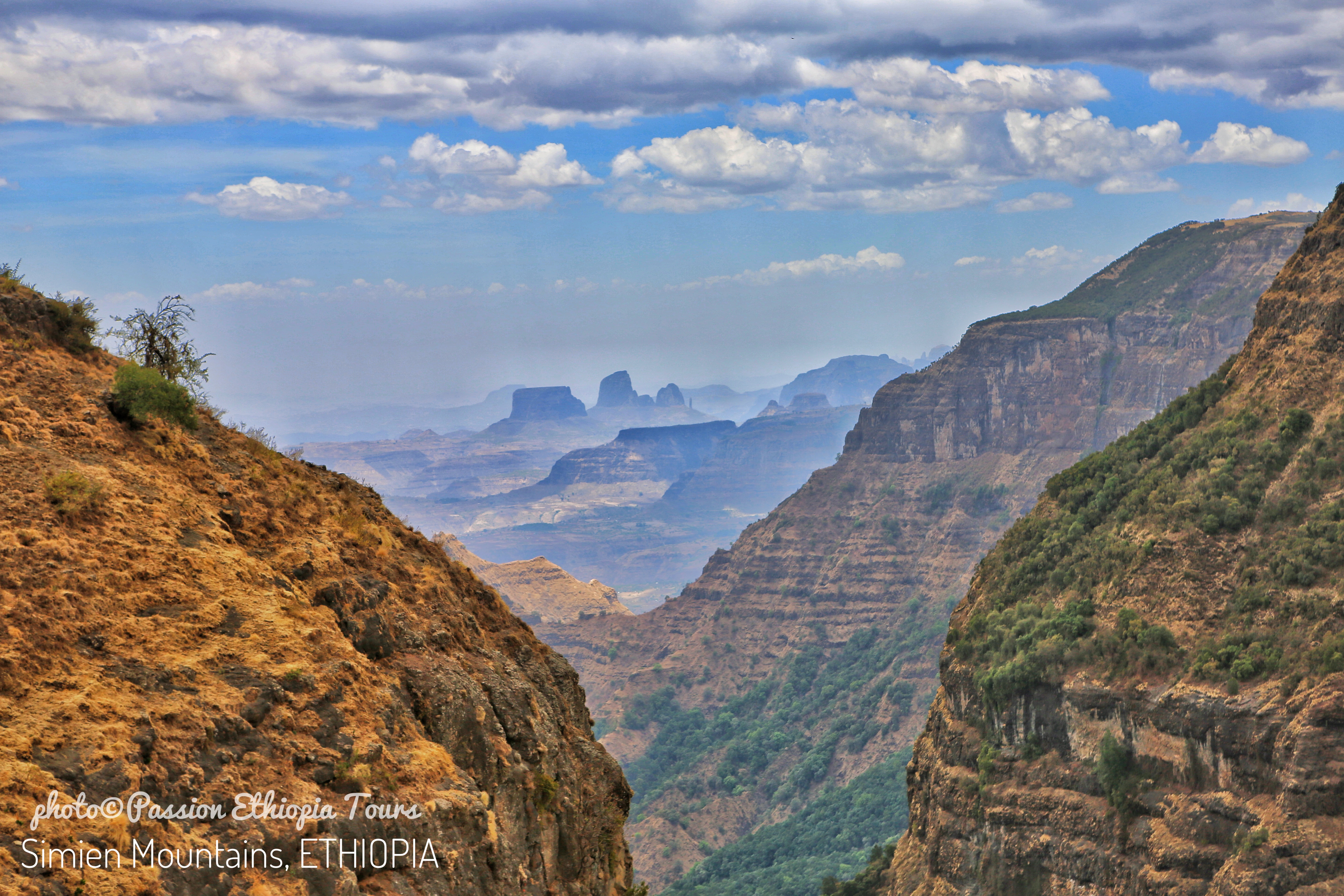
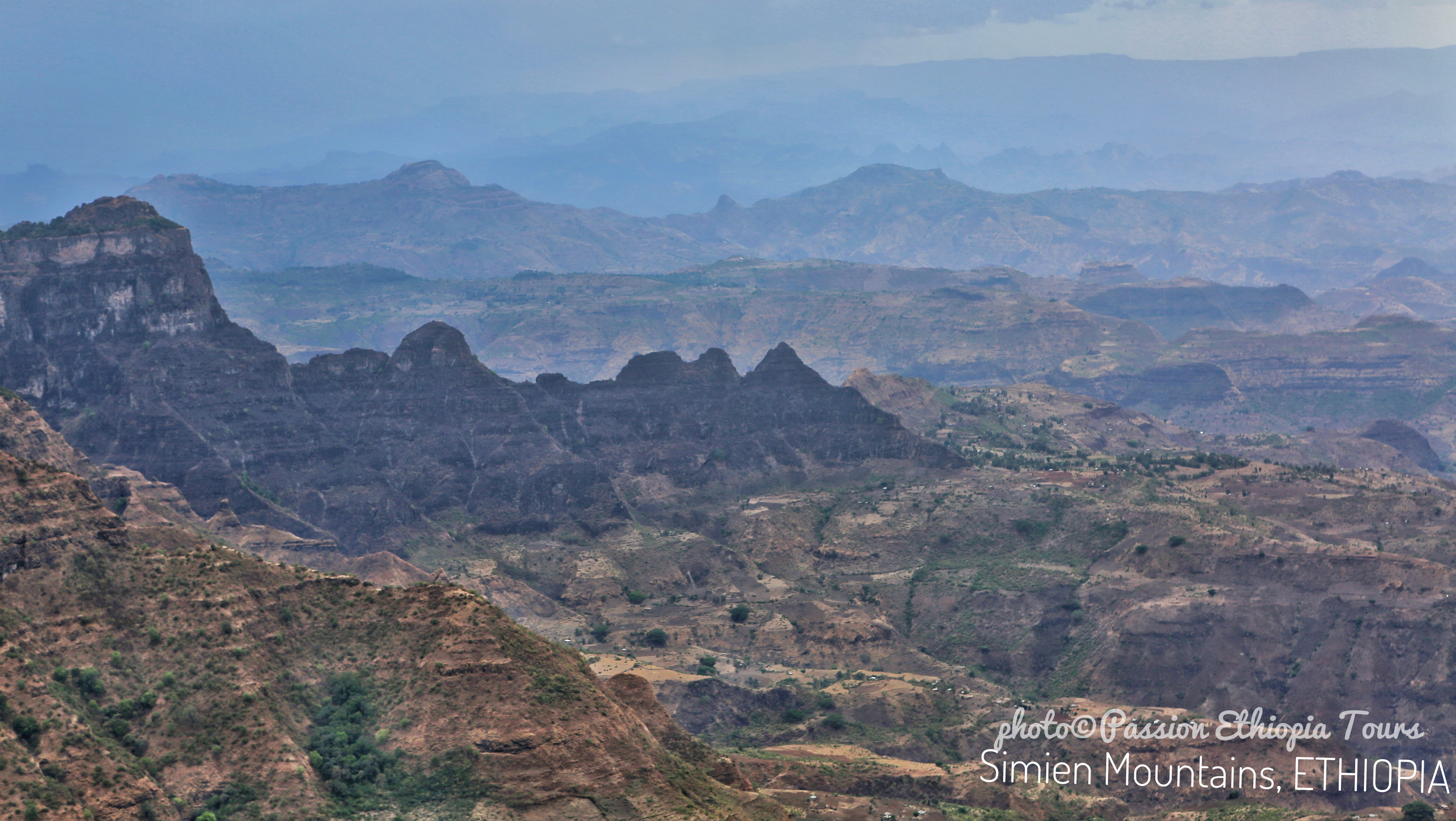
.jpeg)
